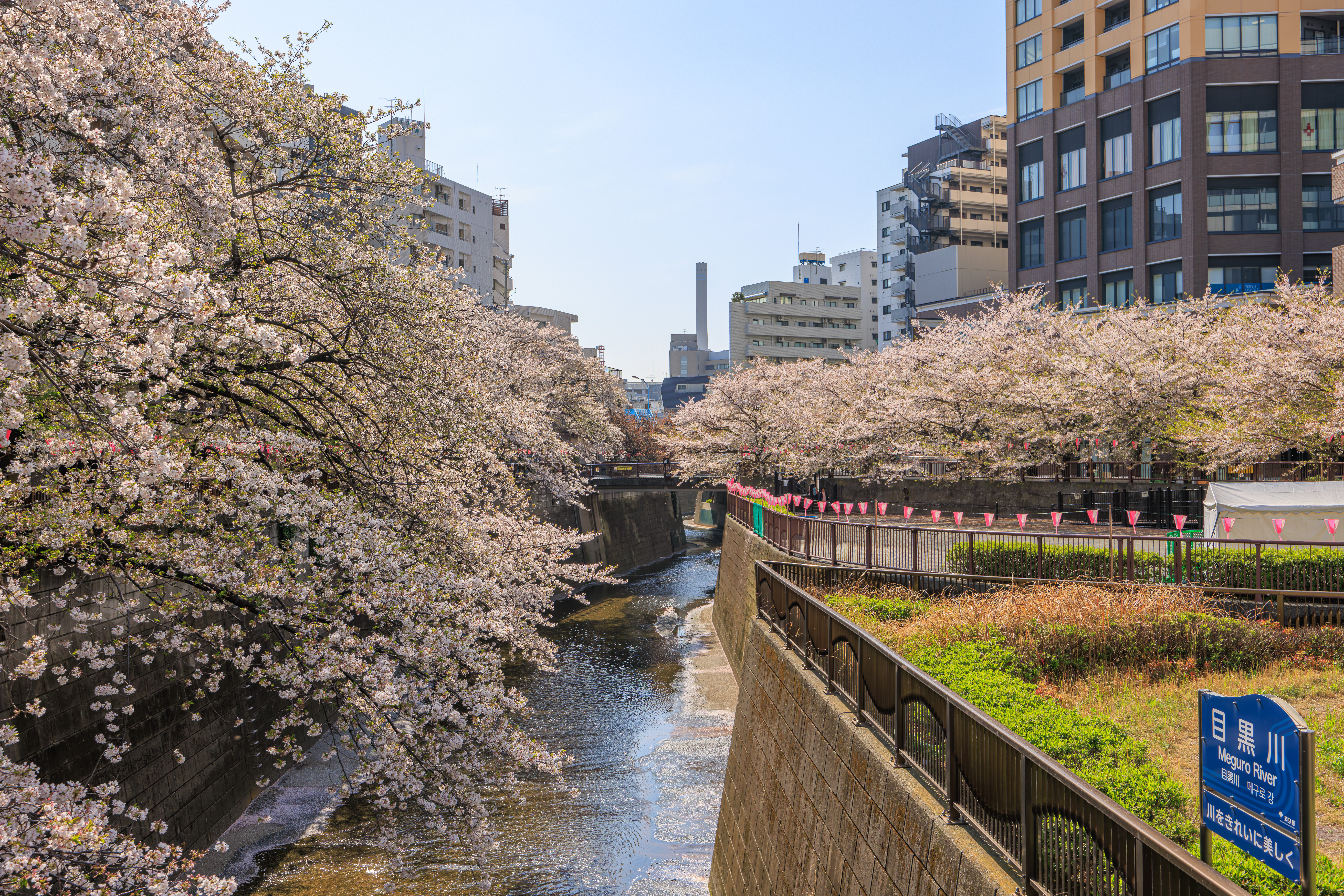Our first full day of the trip! After an excellent breakfast at the Mesm, we headed out to the Meguro River to see the riverside sakura. We then went to the Sumida River around Tokyo Skytree for more sakura before having a late kaiten sushi lunch. We ended the day at Chidorigafuchi where we saw yet more sakura!
Morning
We woke up rather early, not long before sunrise at about 4:30am!

The sky was clear and we could see the Tokyo Skytree towering above everything else in the distance.

The view to the east is not as interesting as there are two relatively tall buildings in the way.

Soon, we saw the sun pop up above the horizon.

We used some of the provided matcha to make tea.
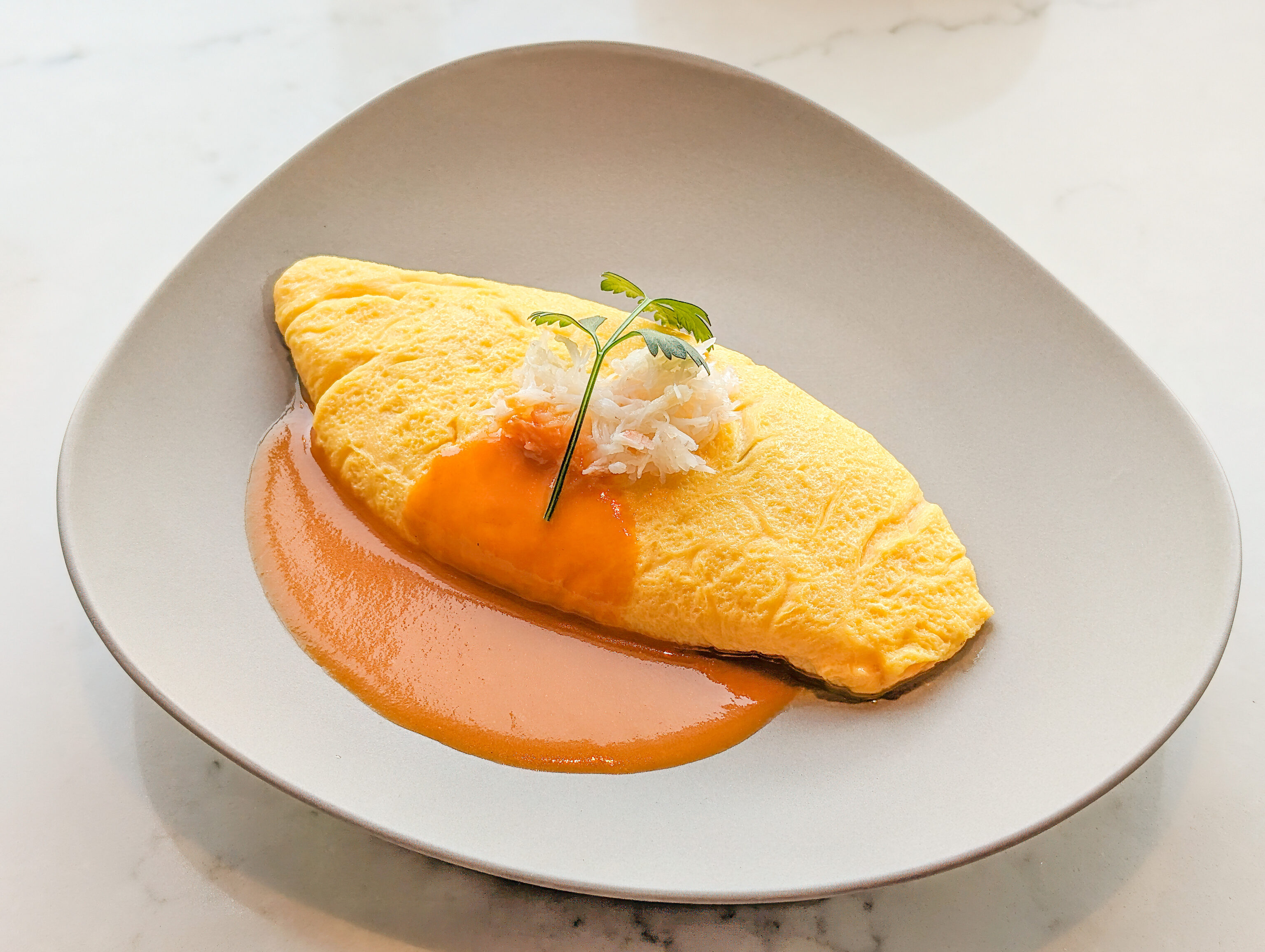
We went down to lobby level for breakfast at 6:30am, the daily starting time. Breakfast is buffet style with an omelette station. We started out with the snow crab omelette. It was excellently prepared and was delicious!
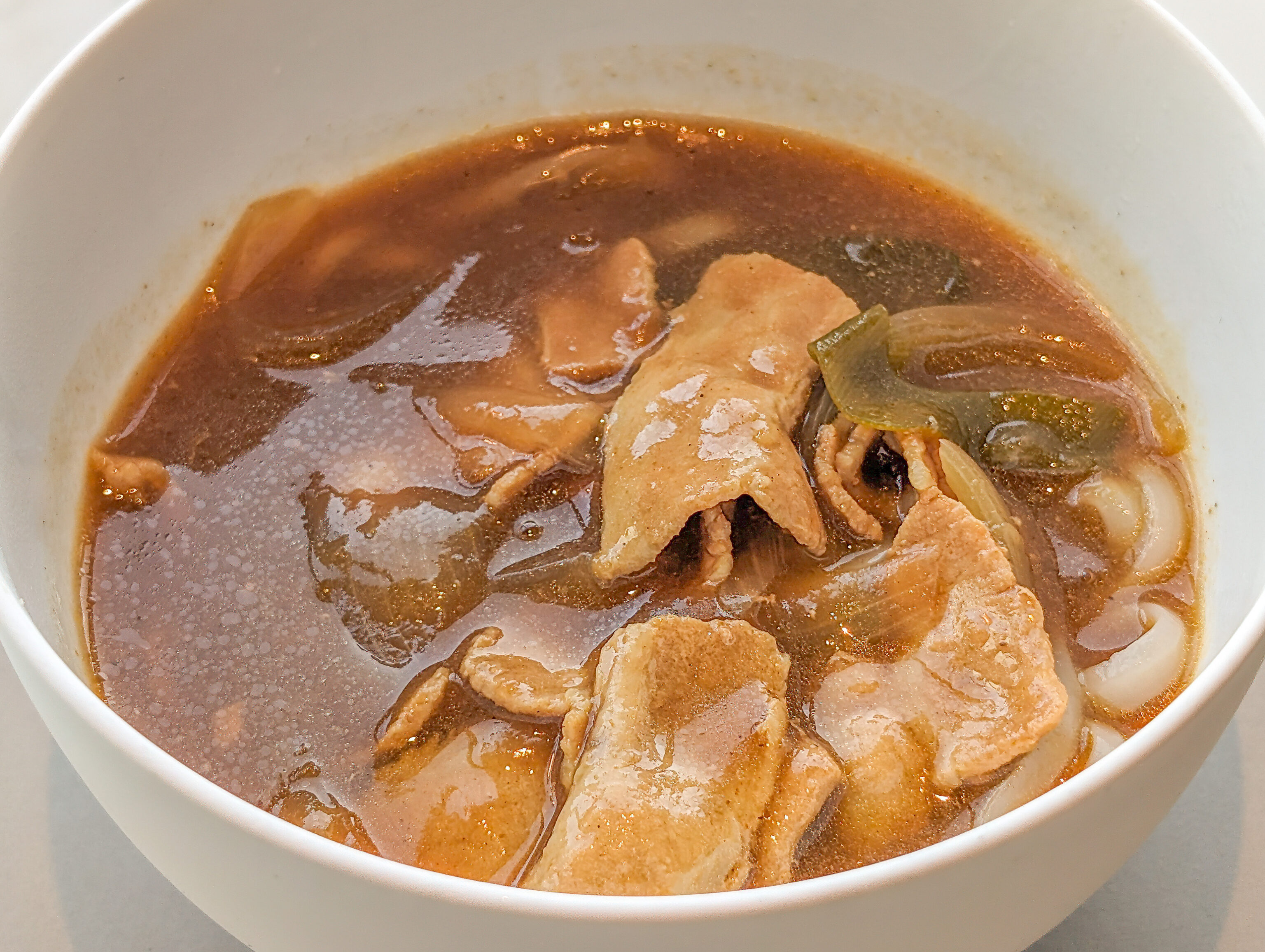
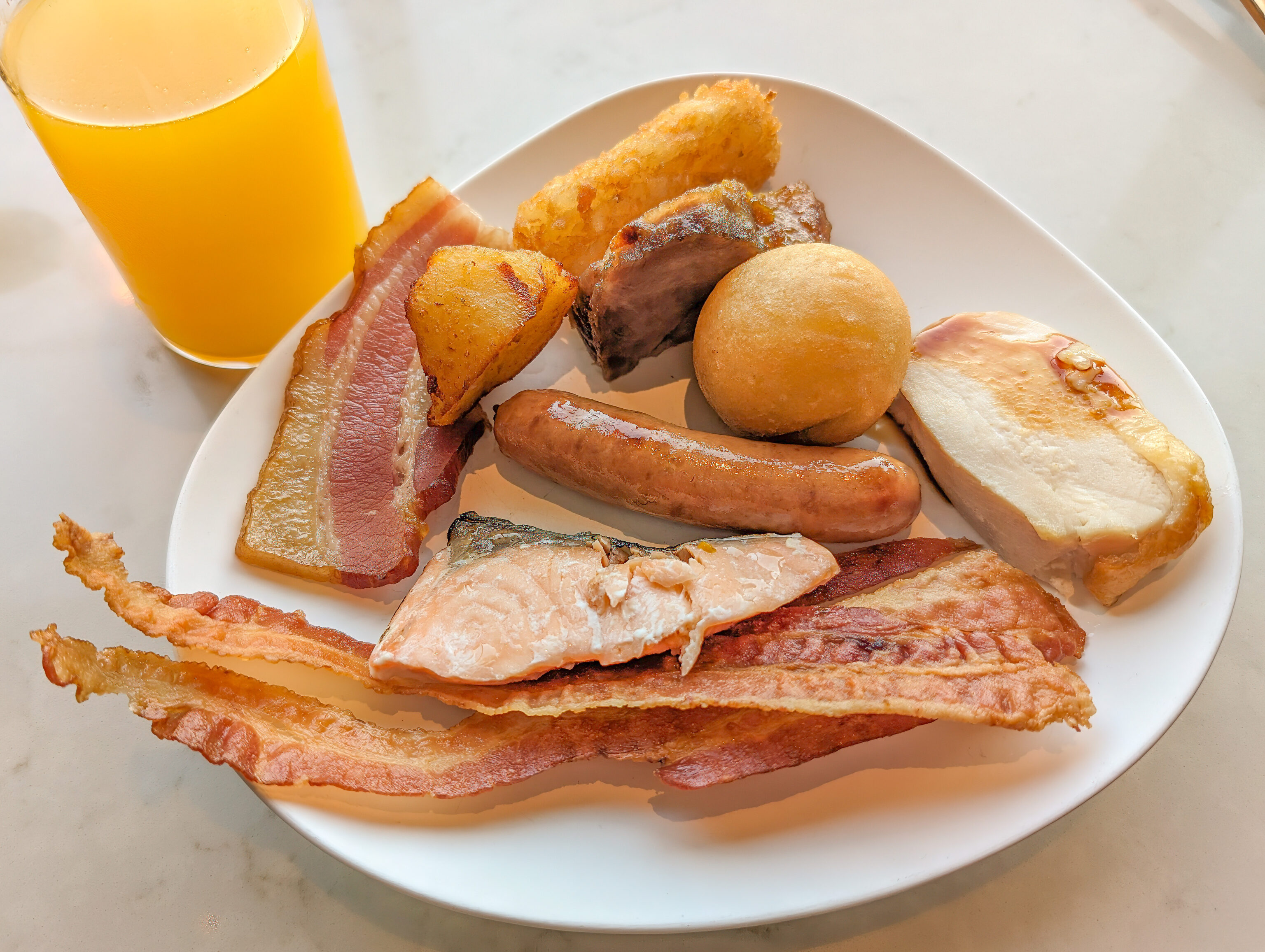

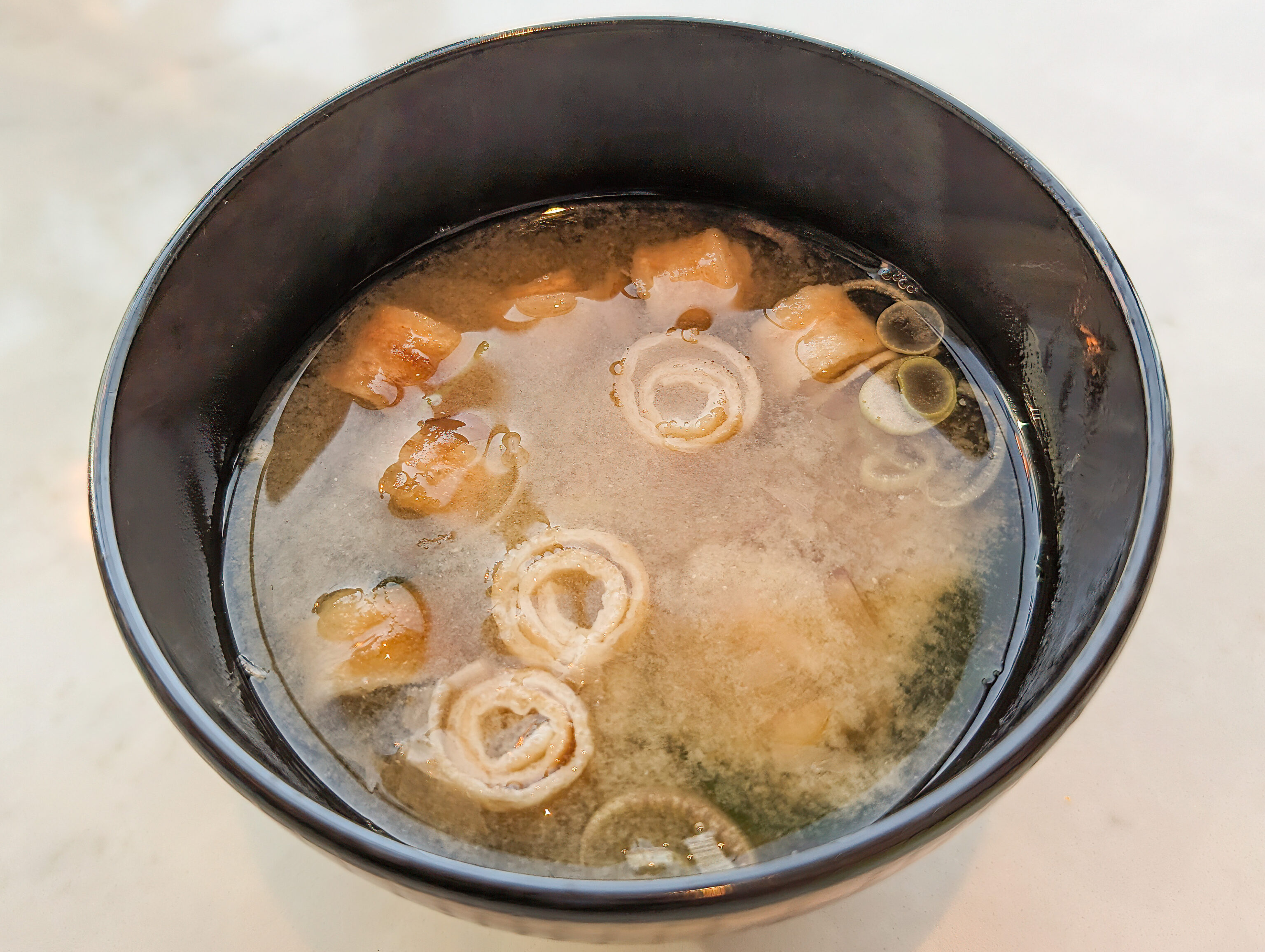
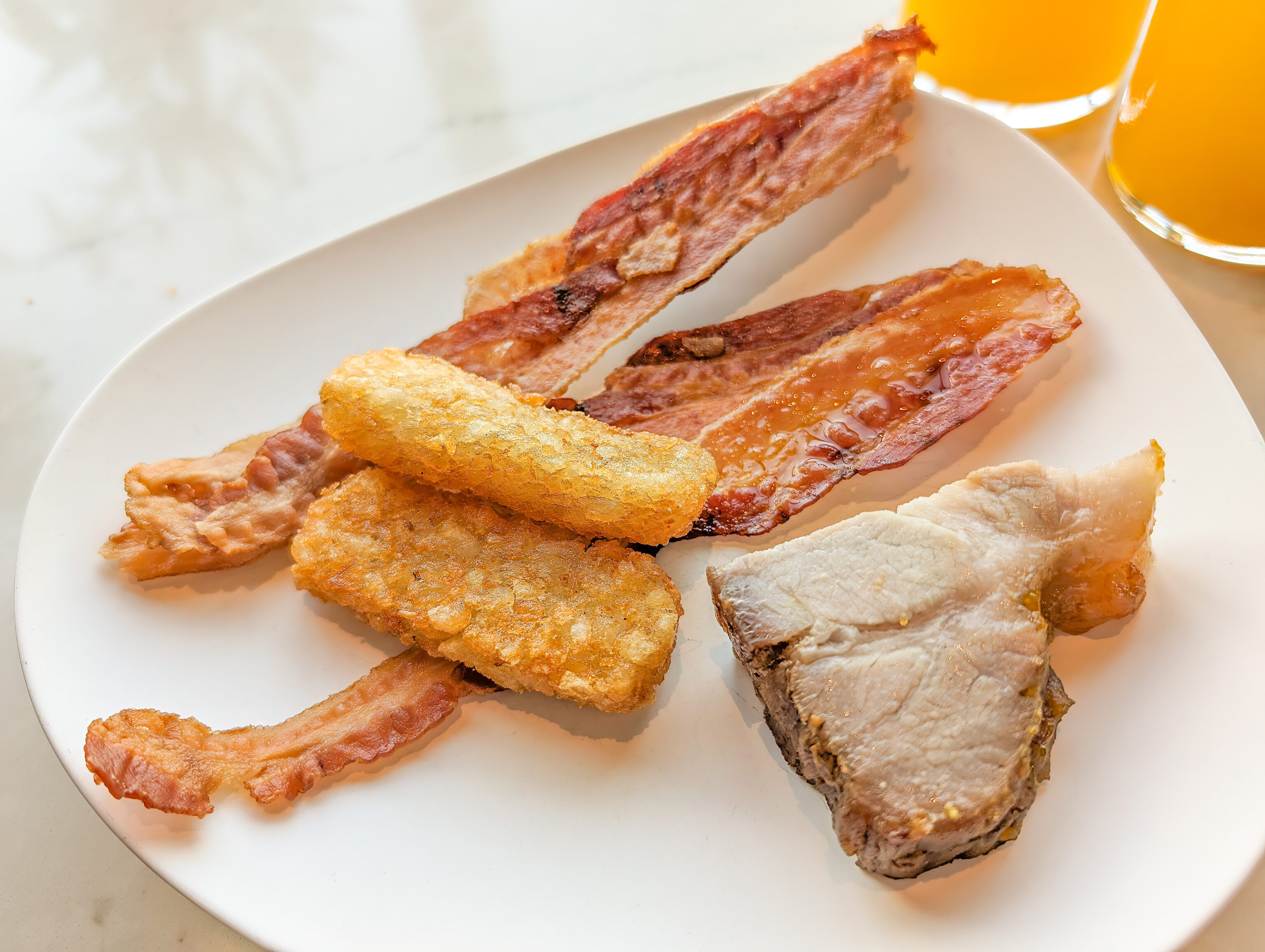
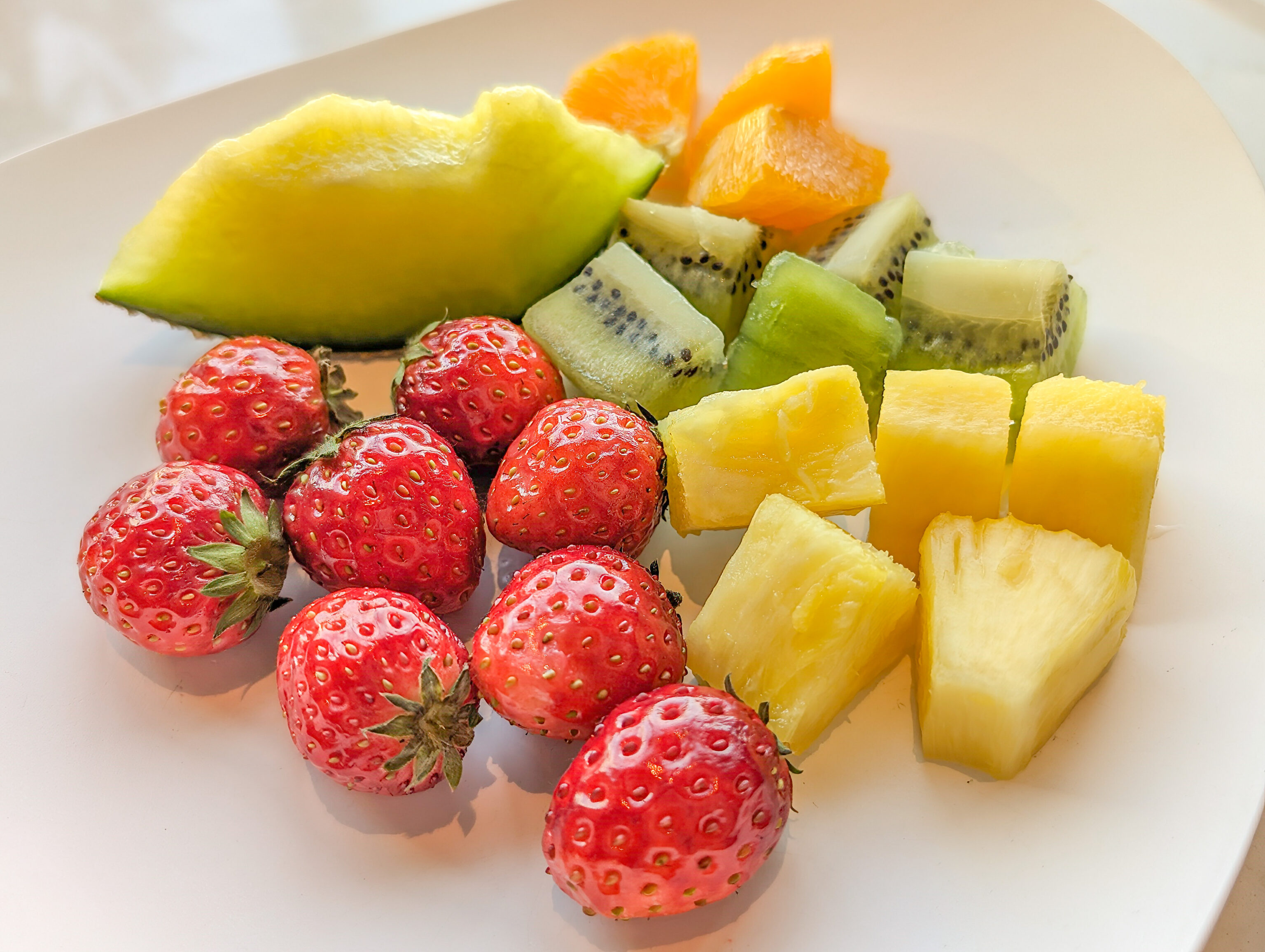
The buffet has a variety of western and Japanese dishes. Overall, it was a fantastic way to start the morning!

The “Gokan Drinks” set was interesting with a variety of different drinks, kind of like a wine flight but with juices.

We headed out at 8am. There was a pretty sakura display in the lobby, directly across from the front desk.

Yesterday, we noticed that there was what seemed like an elevated pedestrian walkway. So, we went to give it a try. The entrance is one block away in front of SoftBank’s corporate headquarters. There is an elevator outside the building that goes up to the walkway’s level. Once there, we walked towards the JR Hamamatsucho Station.
Yesterday evening, we walked by the sakura trees below while on our way back to the Mesm.

The elevated walkway runs parallel to the northern edge of the Kyu Shiba Rikyu Gardens. We could see that this garden had a few sakura trees.
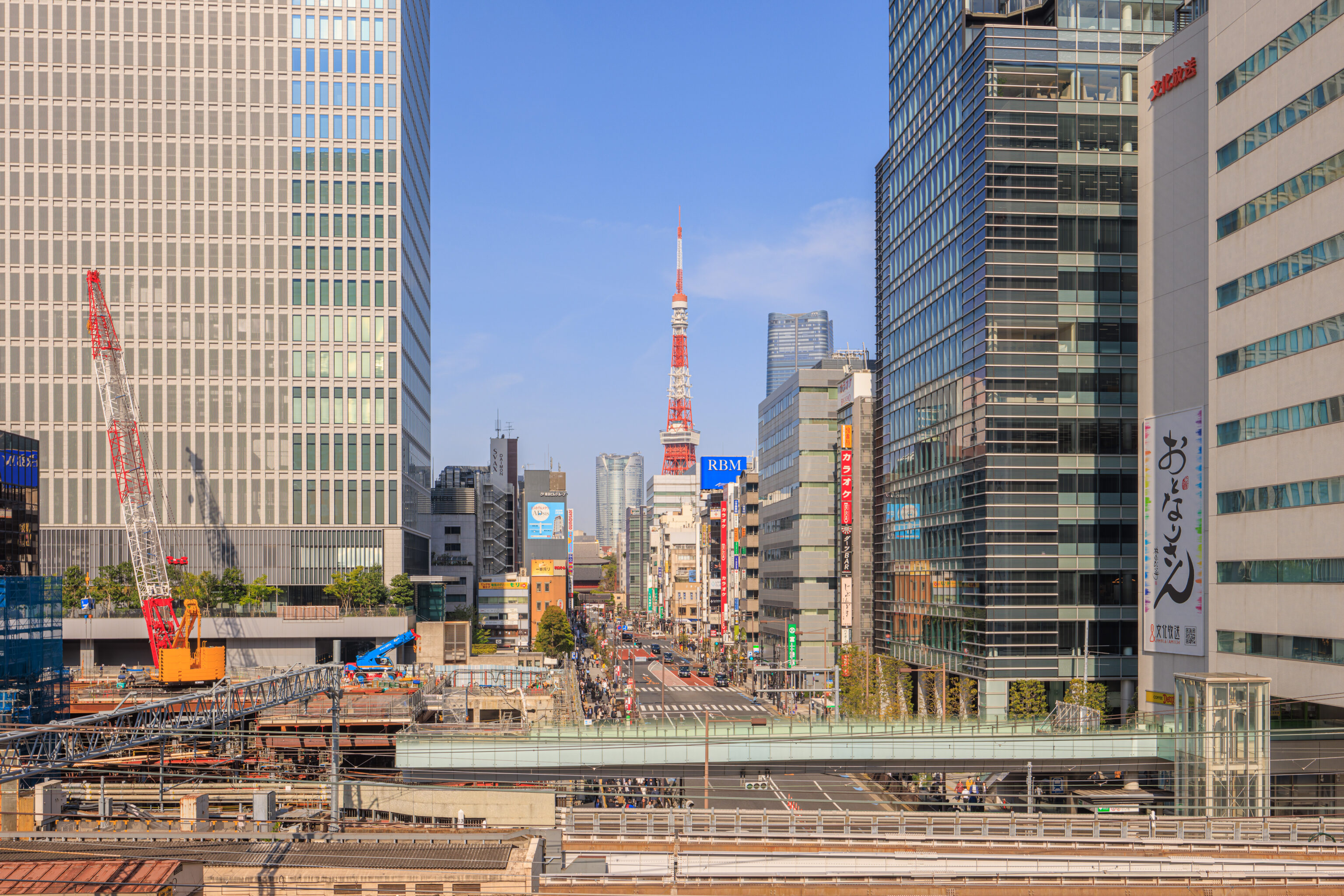
We continued walking to the west until we reached the end, right by the JR station. The Tokyo Tower was directly ahead.
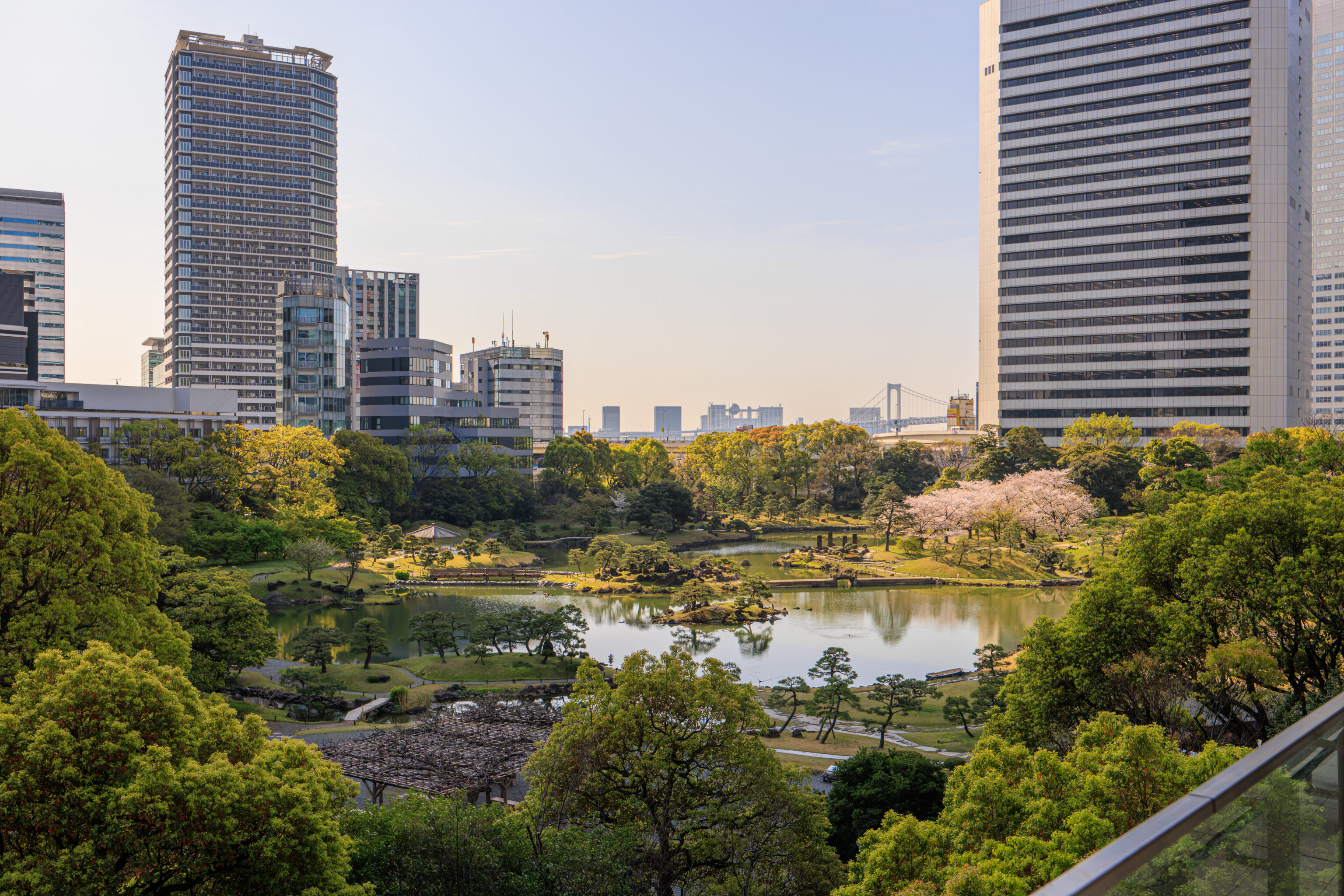
We took another look at Kyu Shiba Rikyu Gardens from the end of the walkway, near the escalators that lead to ground level.
Meguro River
We took the JR Yamanote Line clockwise to reach Ebisu, transferring to the Hibiya Line for the one stop trip to Naka-Meguro.

The station is right by the Meguro River. We could see many sakura trees from the bridge by the northeastern corner of the station.
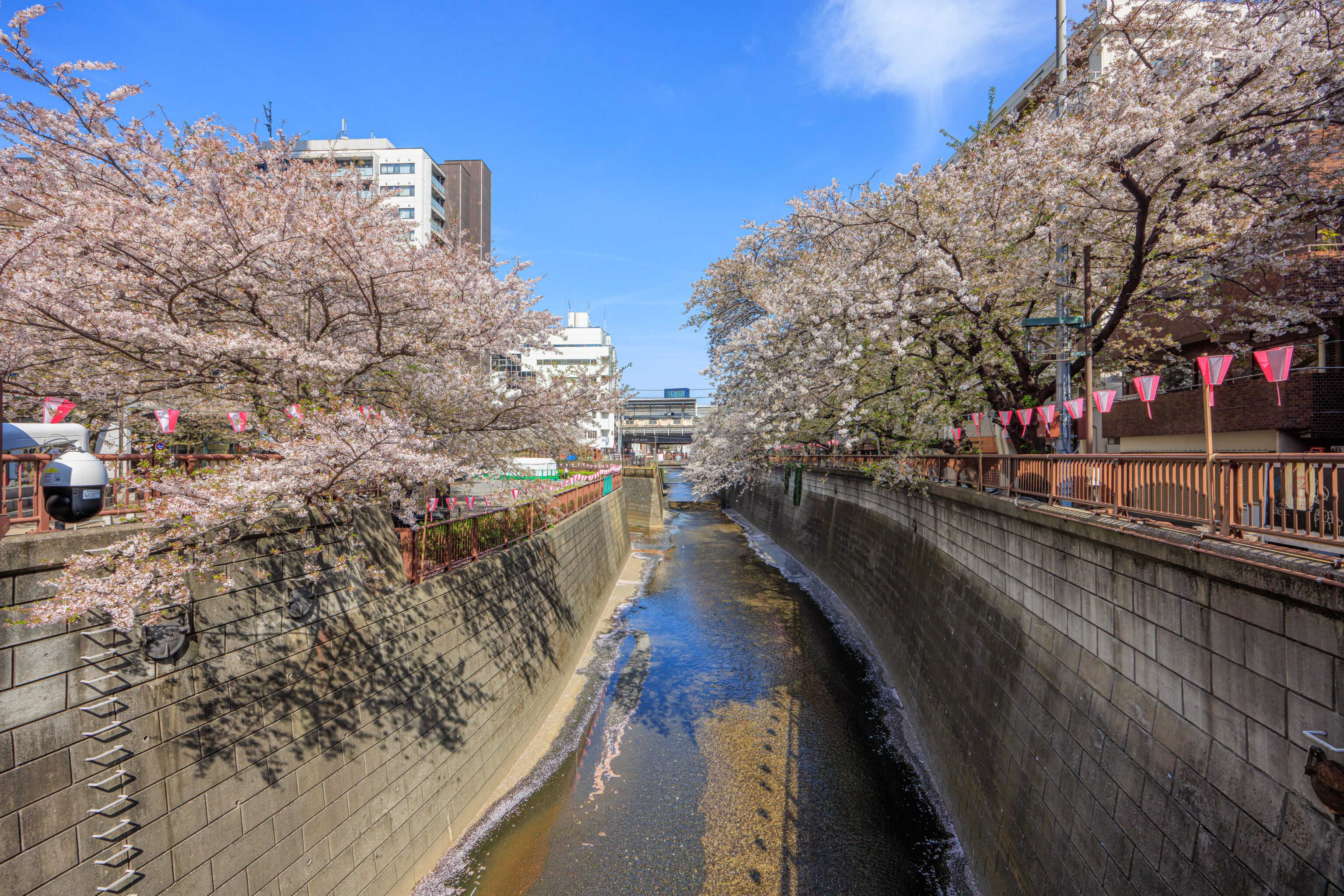
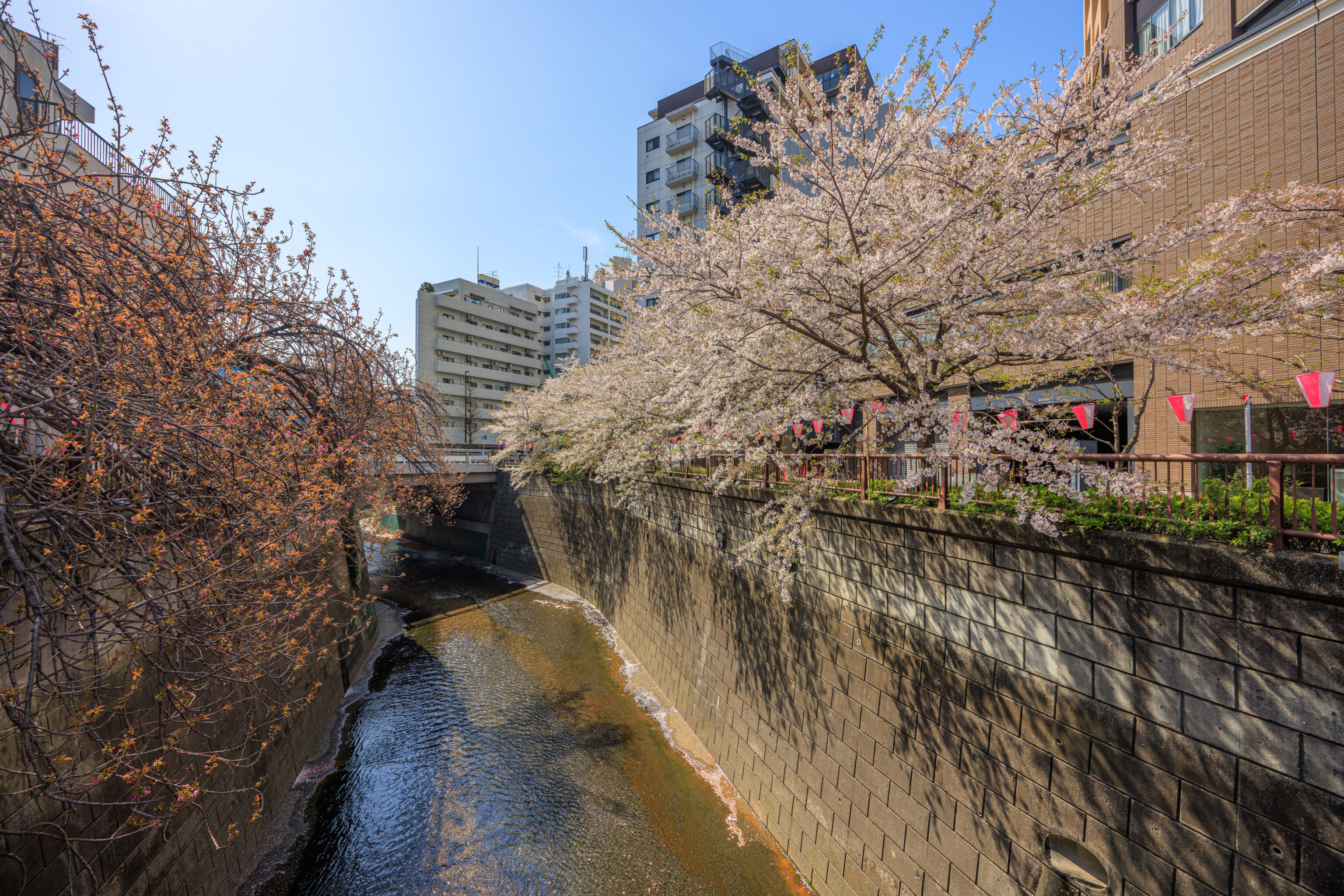
We walked to the southeast first, taking a look from the next bridge. We decided that maybe it would be better to walk upstream, in the opposite direction.

So, we turned around started walking along the river to the northwest. Most of the trees seemed to be well past peak with green leaves sprouting and many petals on the ground.
We ended up walking to the middle of each bridge over the Meguro River, photographing upstream and downstream. The following section contains pairs of photos, downstream first. The bridge names are from Google Maps, we have not verified the names.
別所橋 Bessho Bridge


桜橋 Sakura Bridge
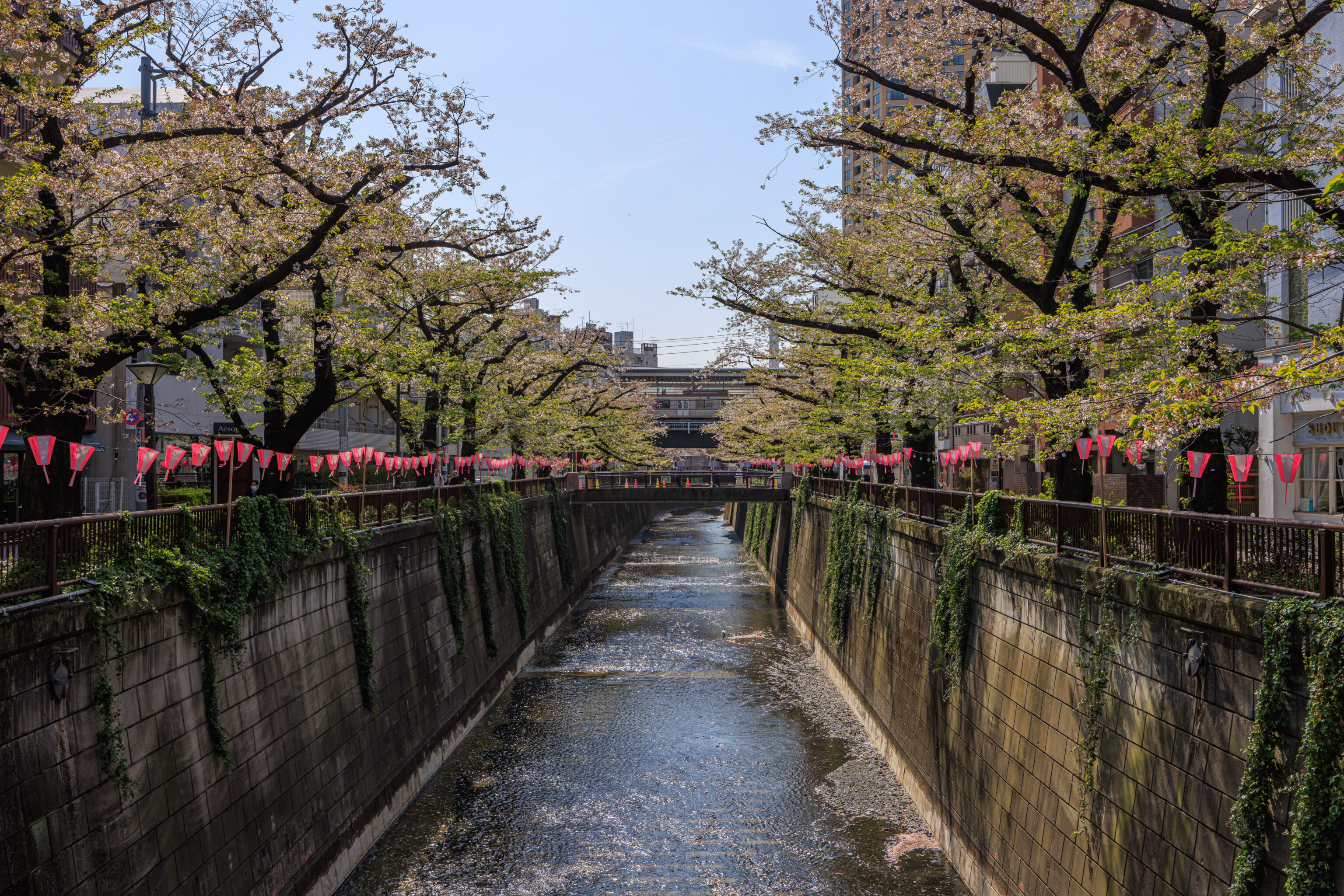
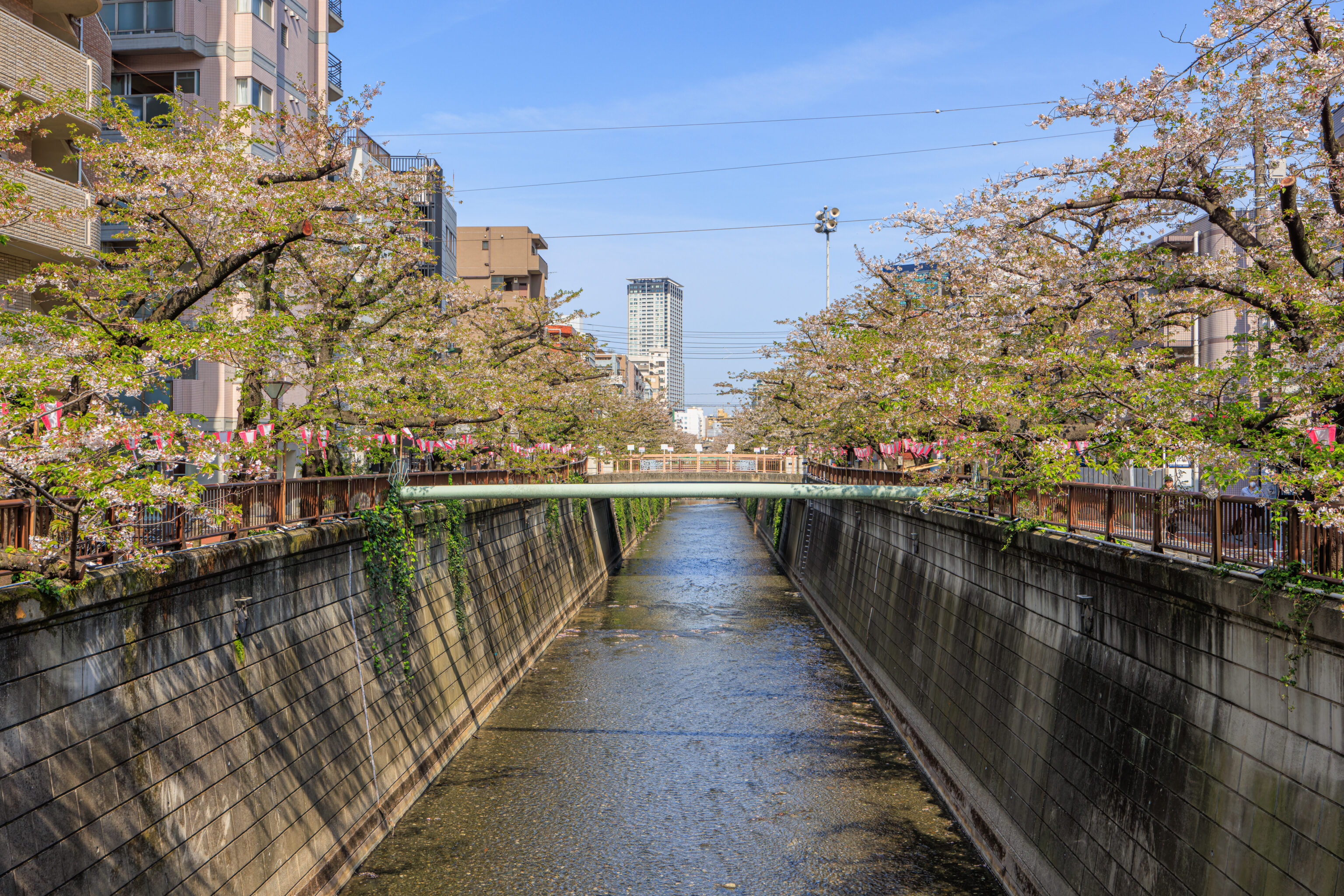
宿山橋 Shukuyamabashi


朝日橋 Asahi Bridge


緑橋 Midoribashi


天神橋 Tenjinbashi

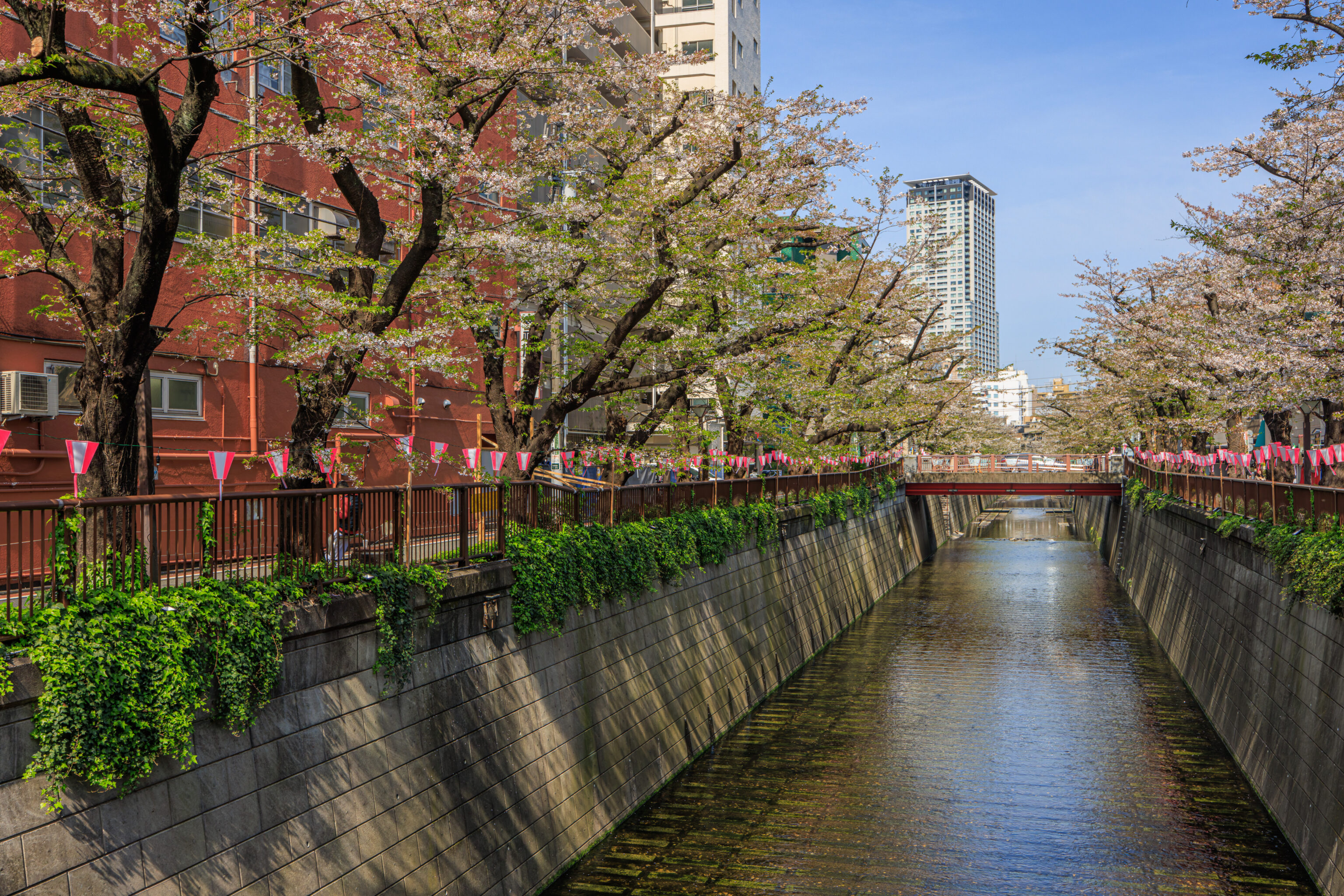
千歳橋 Sensaihashi


柳橋 Yanagibashi


南部橋 Nanbu-bashi

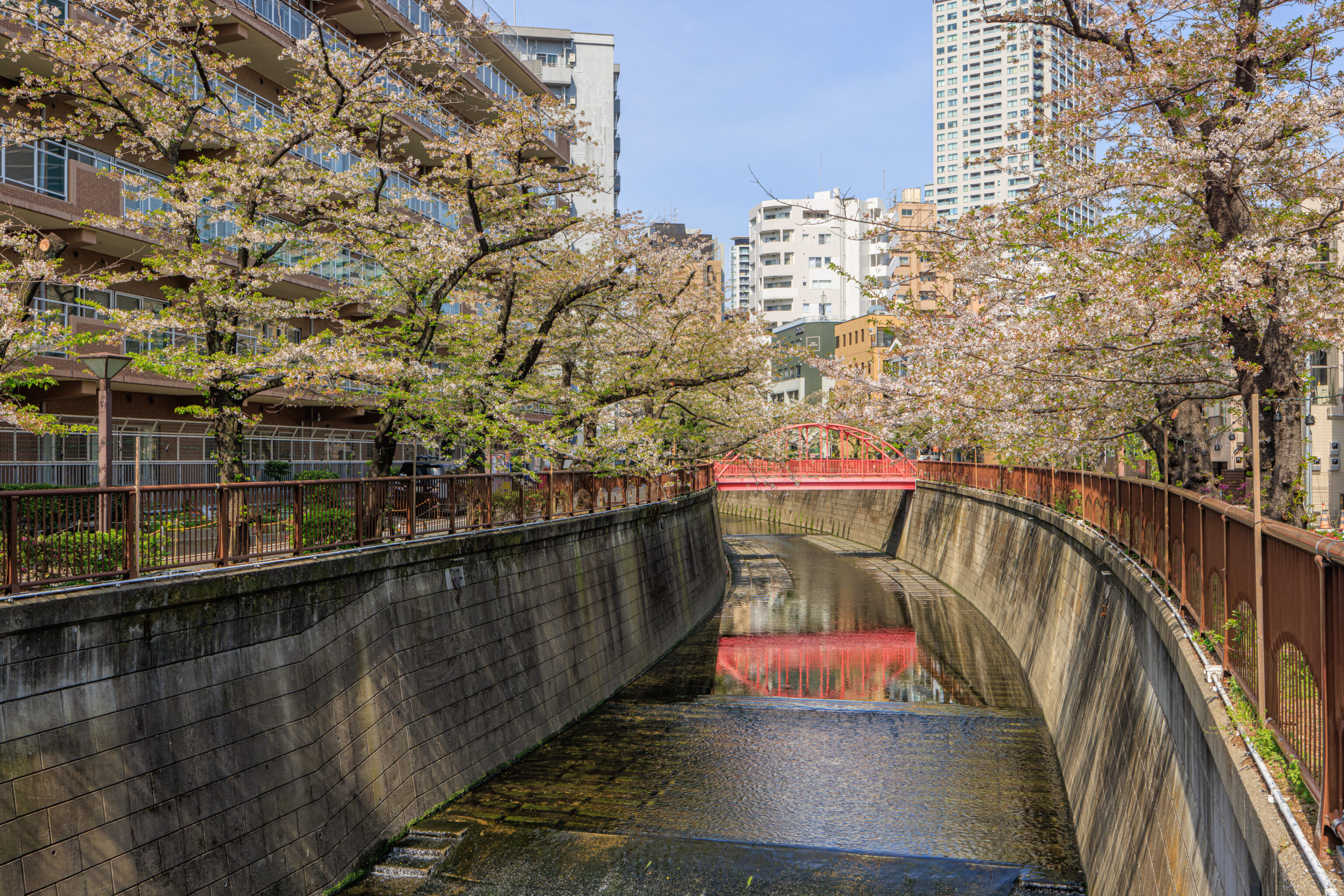
The Meguro River curves upstream from here, flowing from the west.

This corner is home to a rather large Starbucks.
中の橋 Naka Bridge

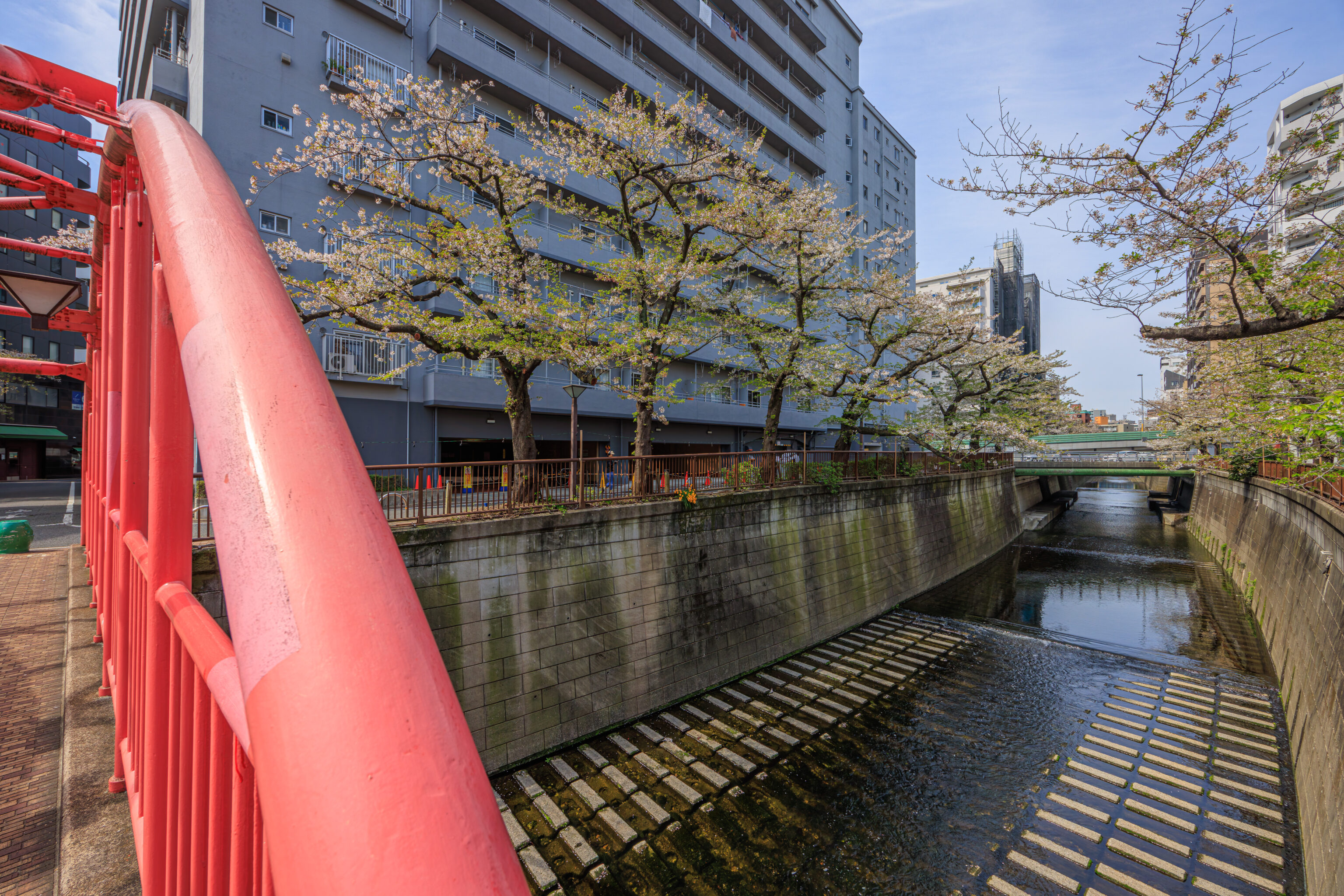
Unlike the other bridges we’ve crossed, this one, with its red metal frame, is a pedestrian bridge.

Just some random cherry blossoms on a tree trunk.
Yamate-dori

Yamate-dori crosses over the Meguro River via three adjacent parallel bridges, with the two outer bridges having sidewalks on their outer sides. We walked to the north to find a crossing.

We passed by a School Bus Coffee on the way! We first encountered this small chain in Kyoto as they had a shop at the Hyatt Place Kyoto where we stayed during our last trip to Japan!
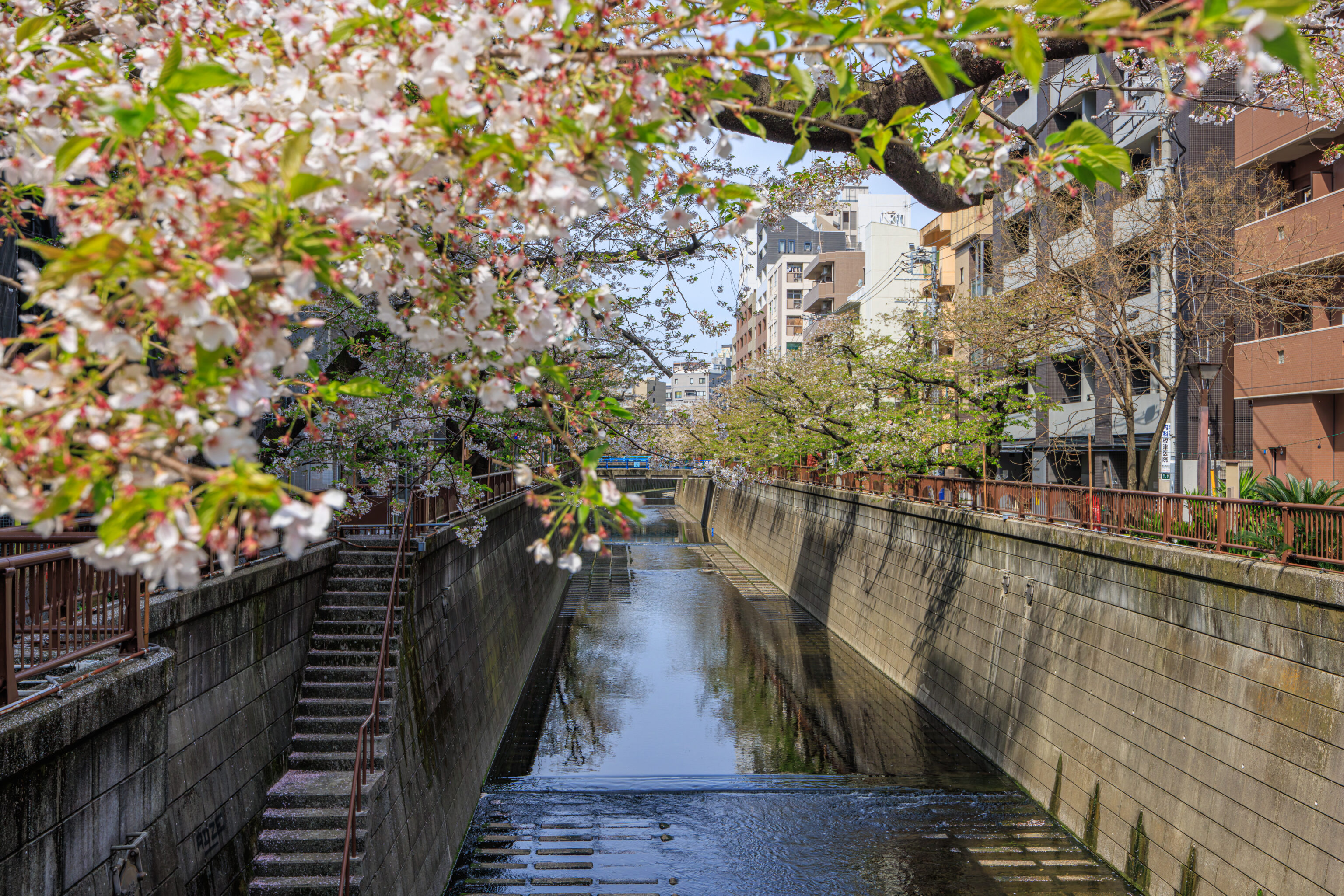
We crossed the street one block or so away to reach the upstream side of the bridge to continue on our way.
東山橋 Higashiyama Bridge
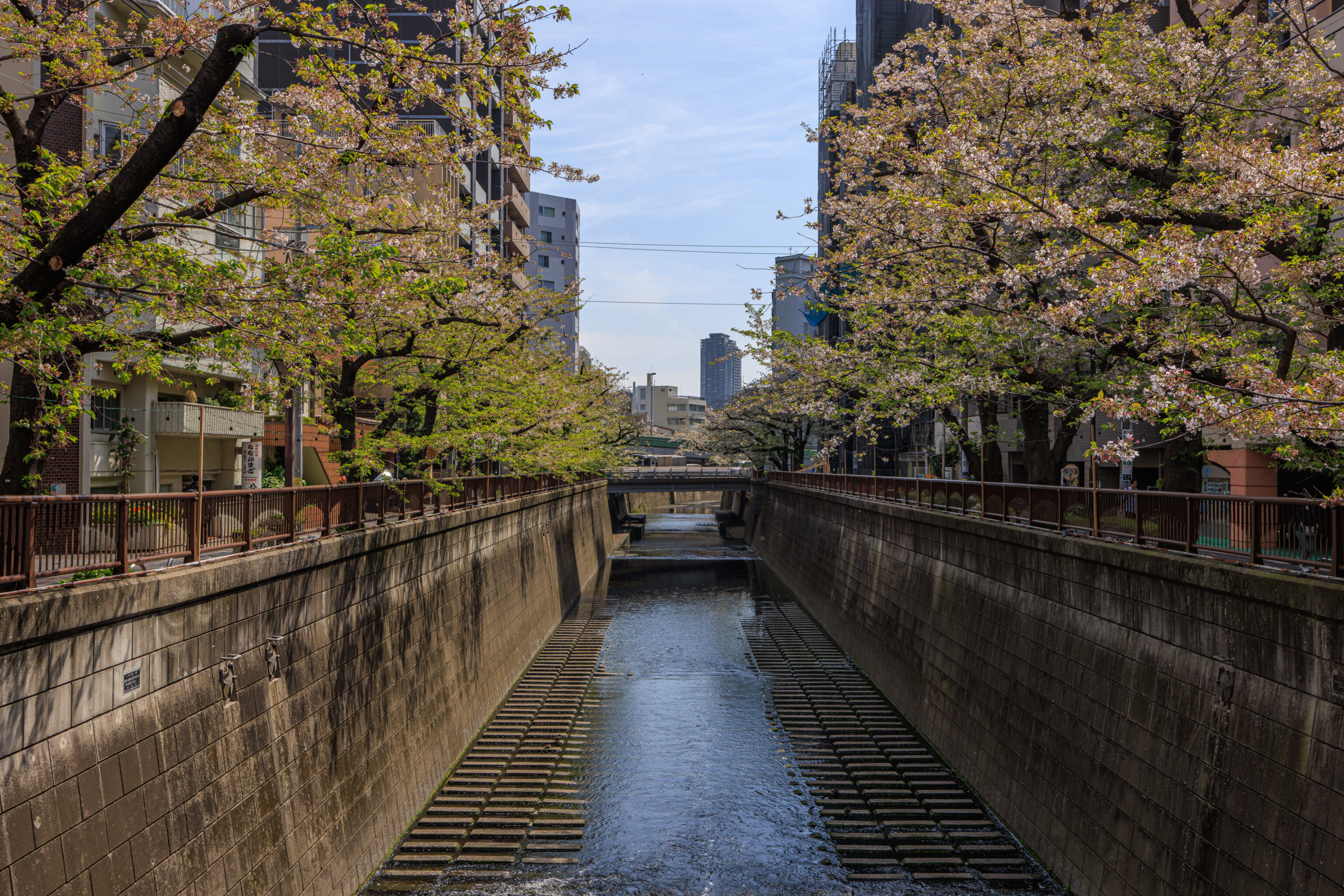

氷川橋 Hikawabashi
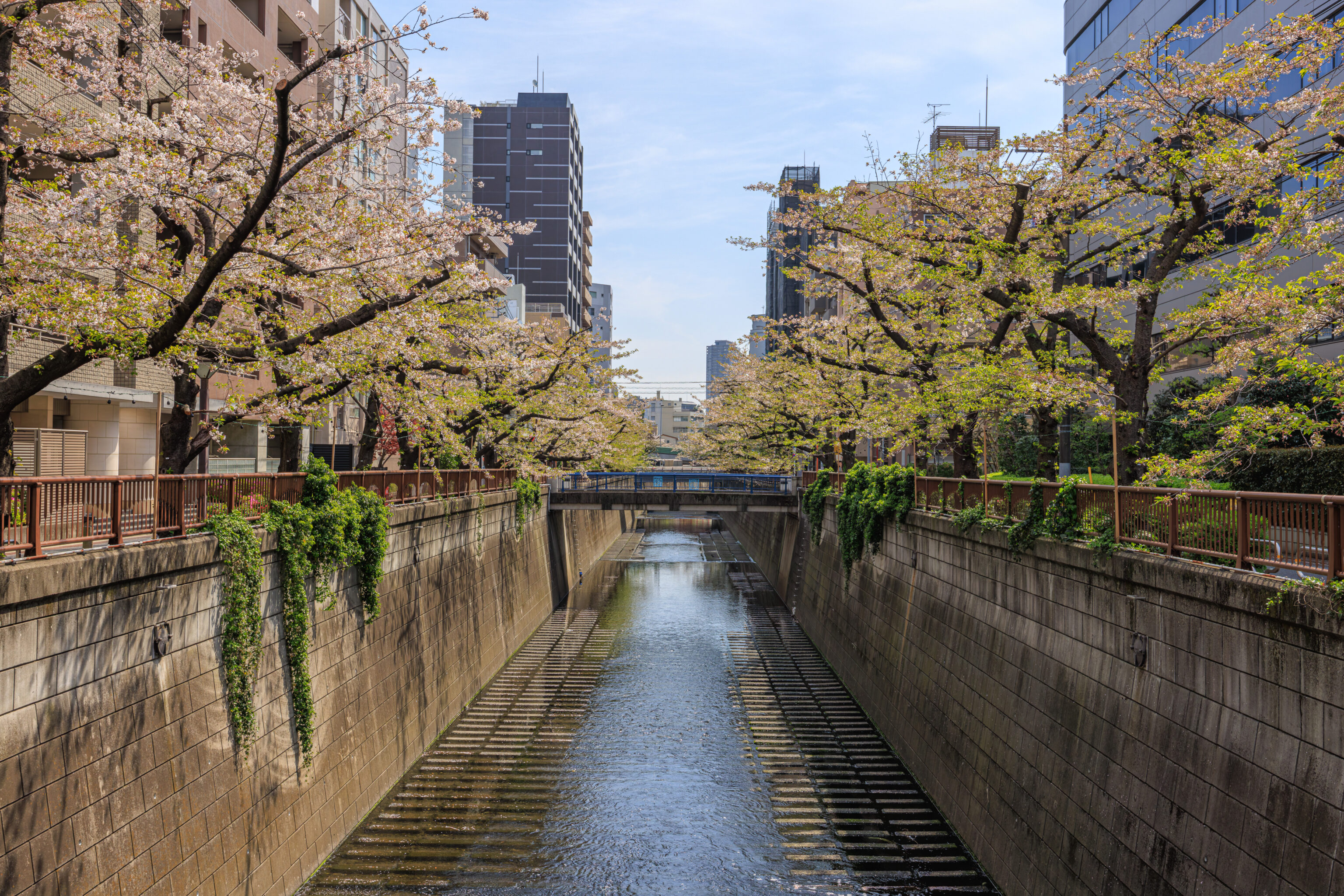

The structure to the right contains the Meguro Sky Garden on the roof. The building is actually an enclosed curved highway ramp. Very weird!
万代橋 Bandaibashi


The sakura trees seem to be getting a bit sparser on the south side upstream from here.
常盤橋 Tokiwabashi
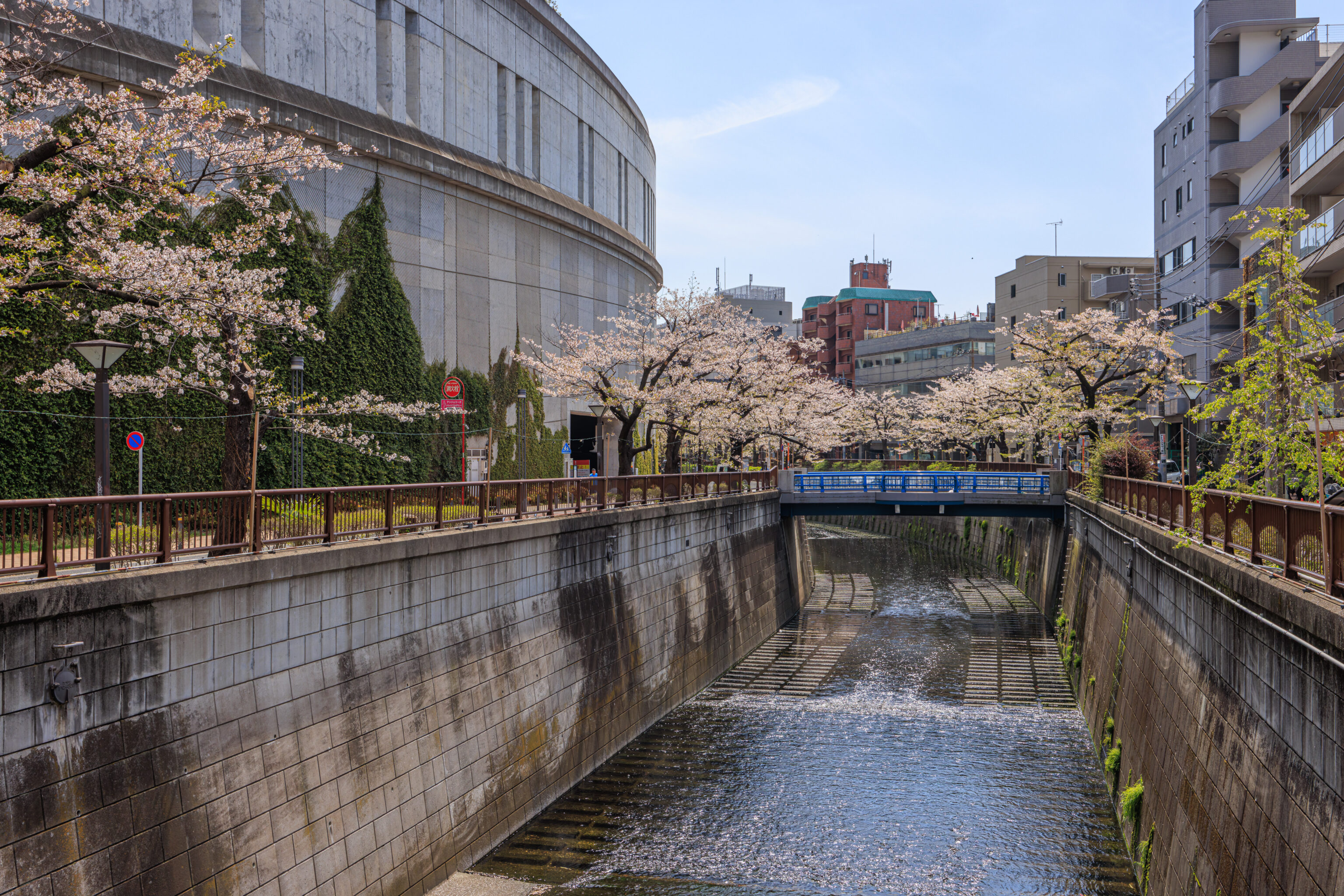
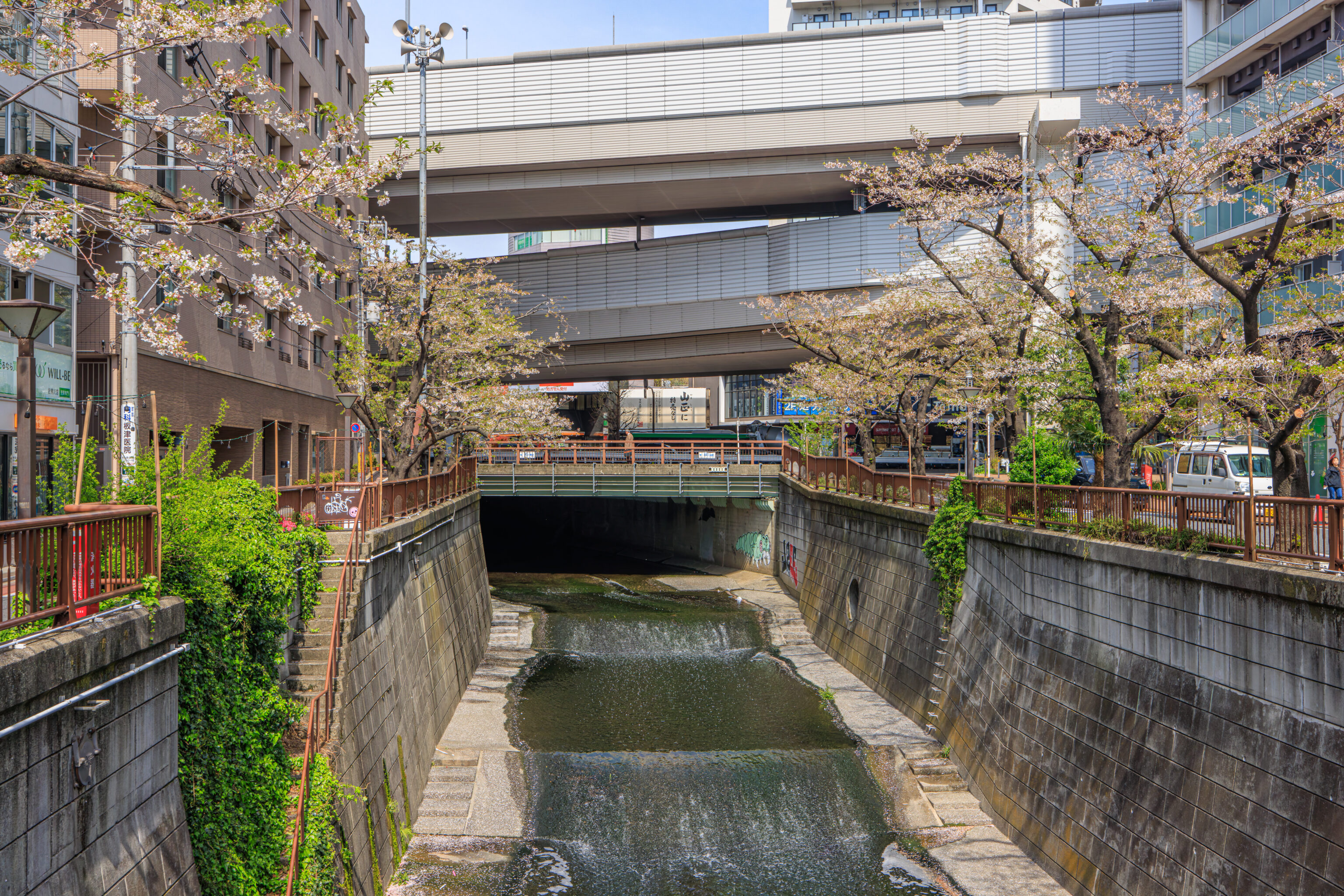
We decided to stop here and walked over to the nearby Ikejiri-ōhashi station to head to our next destination.
Sumida Park
We took the Den-en-toshi Line to Oshiage, the Tokyo Skytree station, where we transferred to the Asakusa Line to for Asakusa Station.
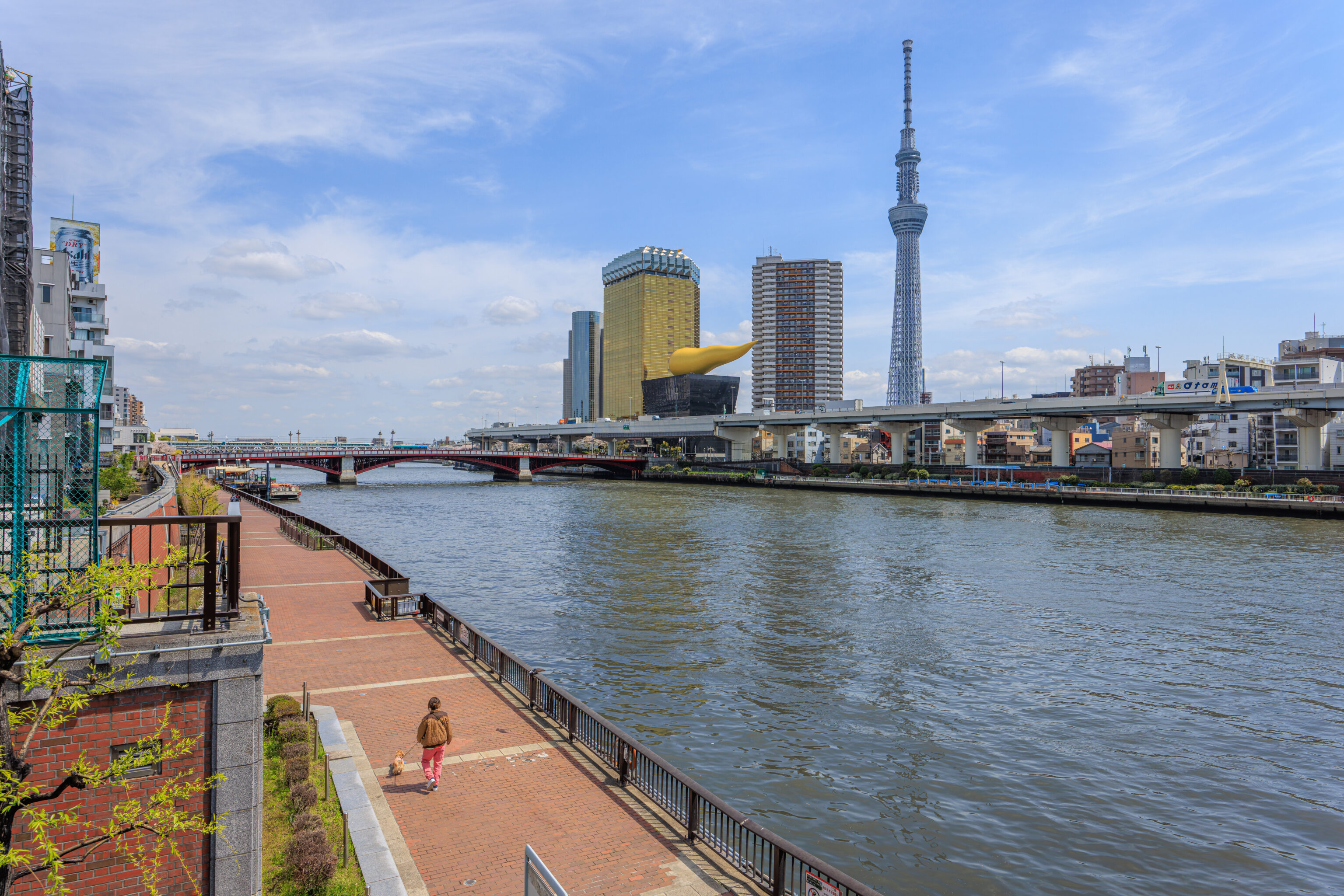
Sumida Park, along the Sumida River near Tokyo Skytree, starts here next to Asakusa Station and extends to the north on the west bank of the river for about half a mile.

We actually exited on the south side of the station so had to walk to the north to reach the park.

There are a few river boat piers here near the subway station.

The park starts by the 吾妻橋 Azuma Bridge. We saw a very beautiful sakura tree with a fully canopy of flowers! This was the best individual tree that we’ve seen so far! Although its leaves have just started to grow, they were still very small and didn’t detract from the tree’s appearance.

Although we didn’t see too many people earlier while at the Meguro River, it was much busier here. Everyone was enjoying the beautiful weather and scenery.

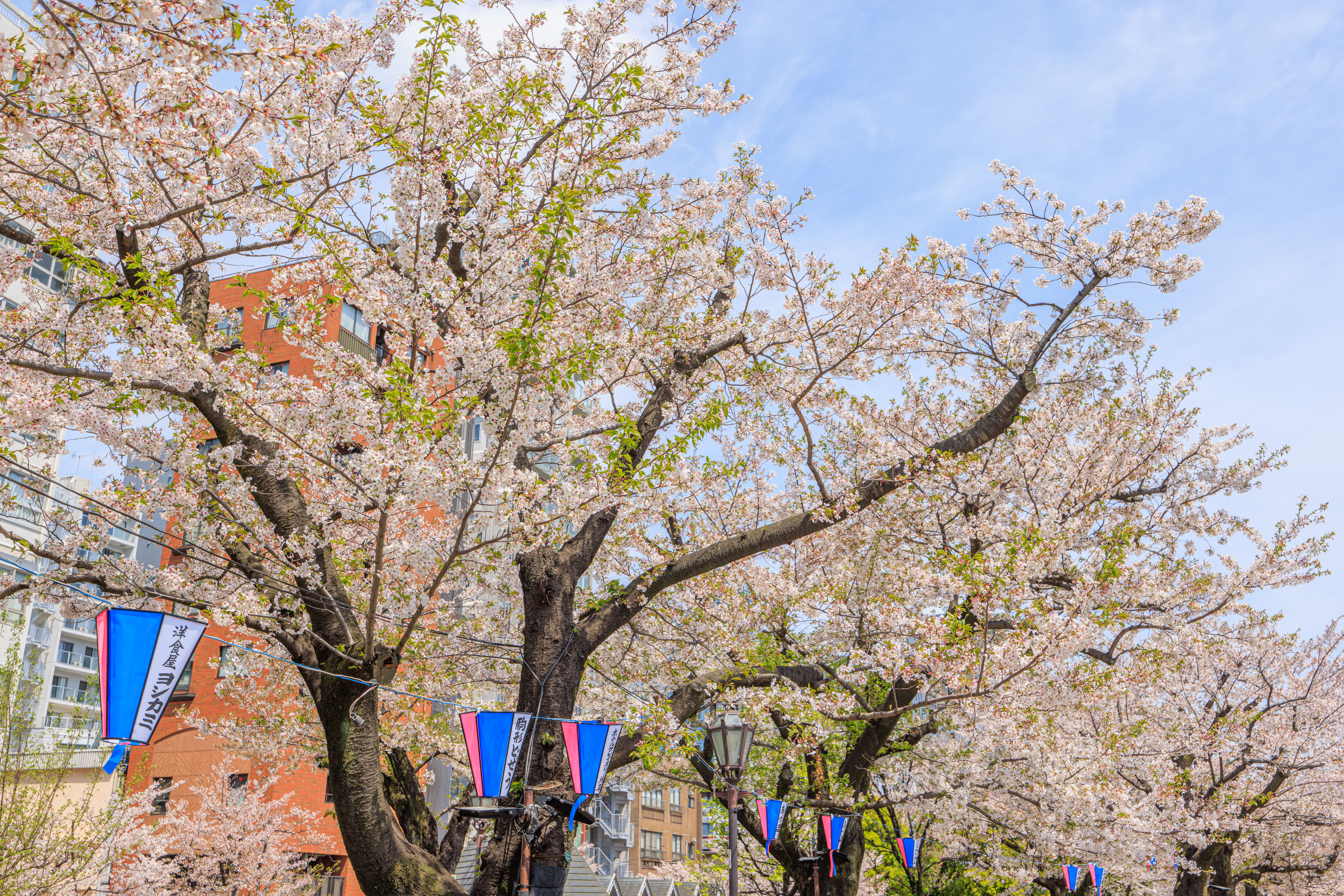
Most of the trees were showing quite a few new leaves and had a medium amount of sakura petals still present.

A closer look at a typical tree.

The birds were enjoying the weather, just like all the humans. Many of the birds in Japan are quite different from those back home. This seems like it might be a Brown-Eared Bulbul?

We passed by a cafe, Cafe W.E. They are apparently going out of business on June 30th. Not sure what the quote on their awning, “Wall for every one,” is supposed to mean. Often, Japanese English is completely incomprehensible.






We continued walking through the park, enjoying the scenery as we went. That tree that we saw at the southern end of the park was still the best in terms of being at peak bloom though.

It looked like there are some very pretty sakura on the east side of the river, below the Tokyo Skytree. We decided to cross over at the next bridge to take a look.
Although it appears as if the Tokyo Skytree is right there behind the trees, it is actually more than half a kilometer away.

There was a nice row of sakura at the edge of a sports center, directly across from the 桜橋 Sakura Bridge.

There were some flowers in a circular planter at the edge of the bridge.

This was the view in the opposite direction. This is a pedestrian bridge.


The downstream and upstream views as we started to cross over the Sumida River.
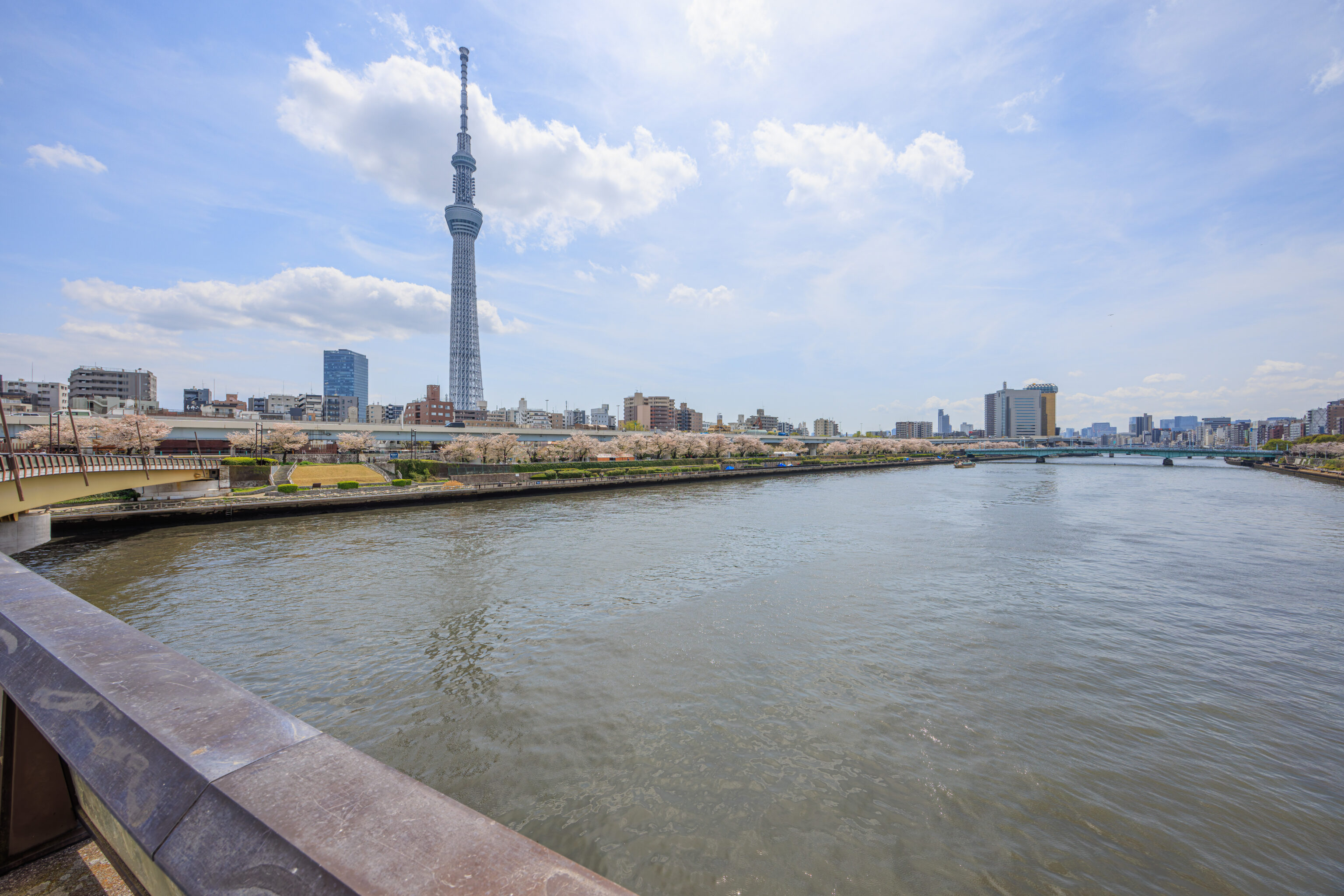
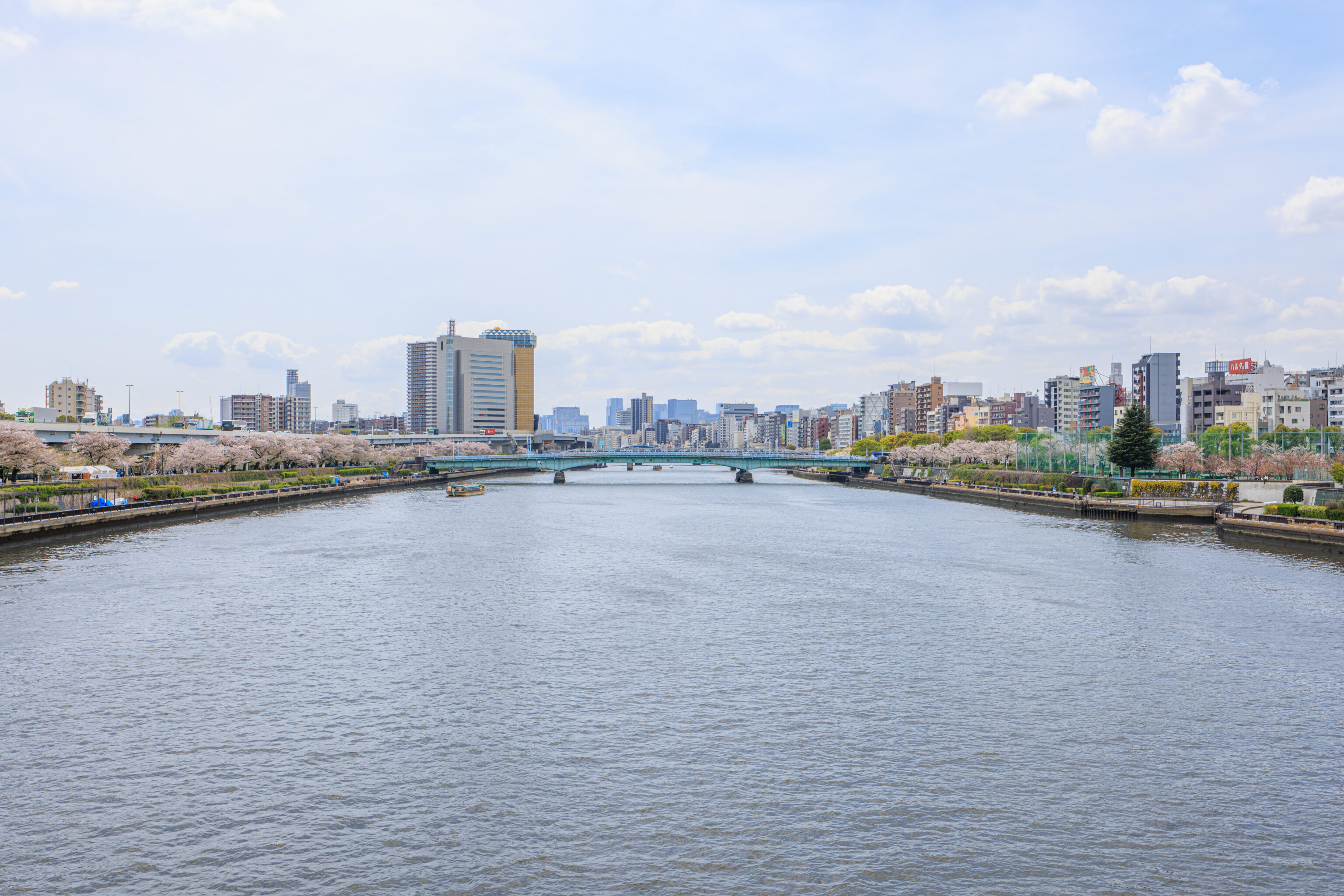
The same views but at the middle of the bridge.

This rendition of “two cranes taking flight” is based on a picture by Ikuo Hirayama, based on Google Translate.

The upstream view from the east end of the bridge towards the west bank of the Sumida River. There is another long row of sakura before the park finally ends.

The upstream east bank of the Sumida River has some sakura as well along with vendor tents.

Looking downstream, there are more sakura on the east bank. These are the trees that we saw earlier in front of the Tokyo Skytree.

After arriving on the east side of the Sumida River, we started walking south along a waterside path. There seemed to be as many sakura petals on the ground as there were up in the trees!

Maybe a bit more leaves than the average tree on the west side of the river?

Its hard to say for sure. We realized that the trees look much better from a distance!
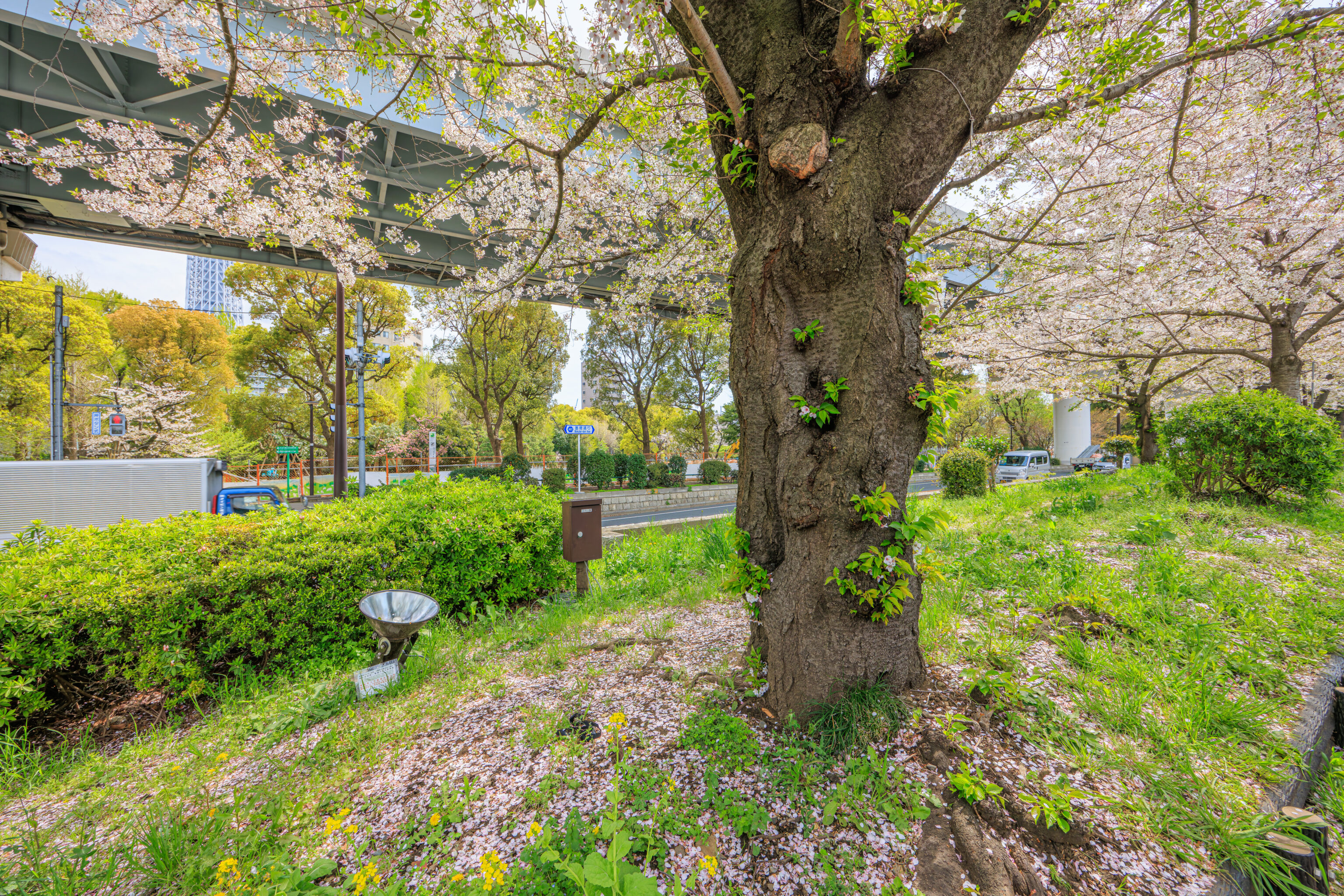
Just a random tree, showing the many sakura petals on the ground.

We saw a few boats on the Sumida River. But in general, it’s never seemed to be a busy waterway. We have yet to ever take a boat in Tokyo.

We probably should have came to Japan a week earlier! These trees were probably at their peak. They’re still doing OK though.

The path sort of ends where an elevated highway curves a bit and starts running right above the river’s edge. We followed a sign for the Sumida River Walk, thinking it would perhaps go under the elevated highway to the next bridge. Instead, it crosses the river at the side of a railroad bridge. So, we crossed back onto the west side here.

We were walking here earlier, though by the sakura trees and not at the actual riverfront.

Looking to the south from the bridge, we can see the elevated highway along with pedestrian walkways underneath it. There are a few sakura trees but not many. Perhaps it wasn’t so bad that we crossed back over the river earlier than planned.
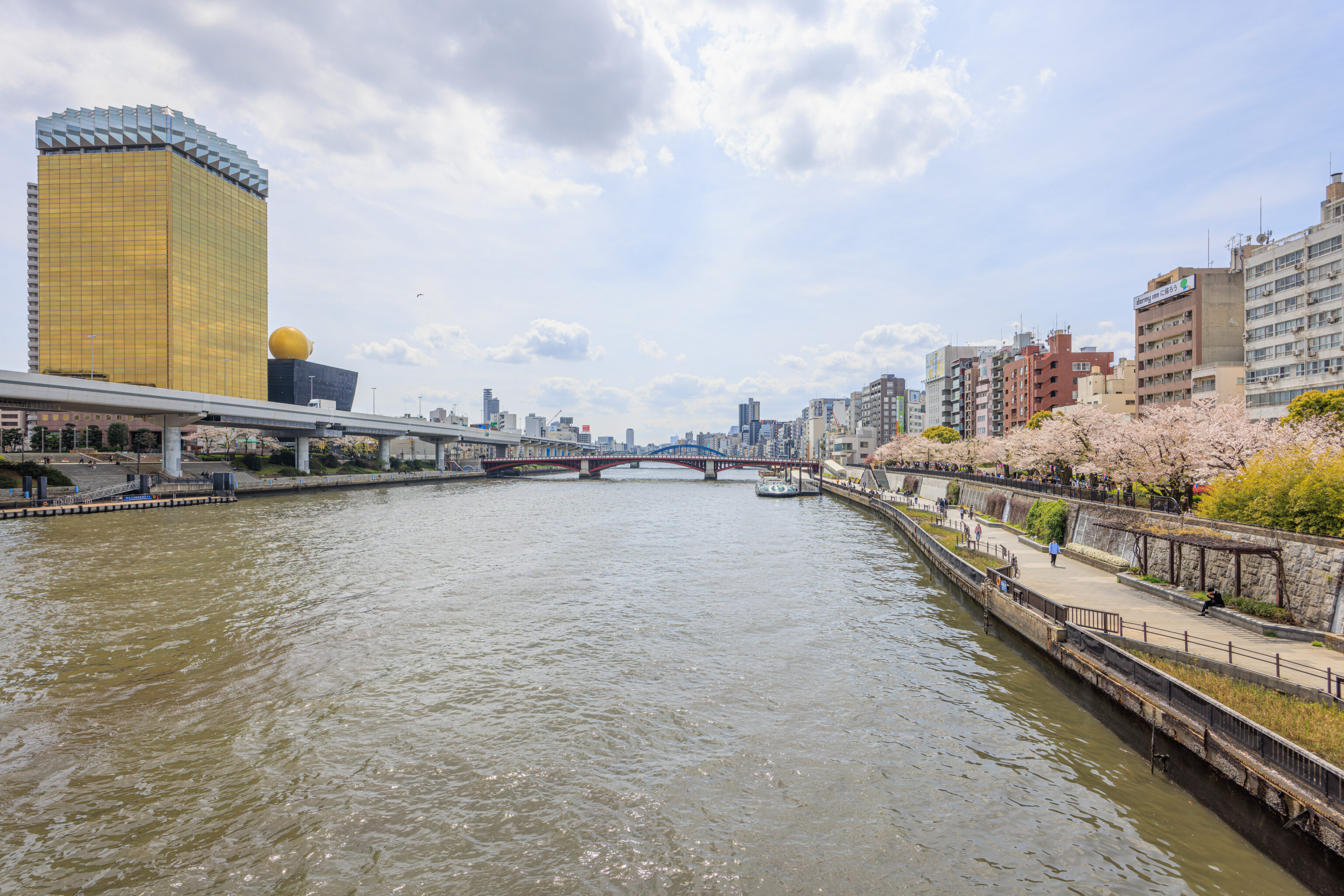
The downstream view, to the southwest.
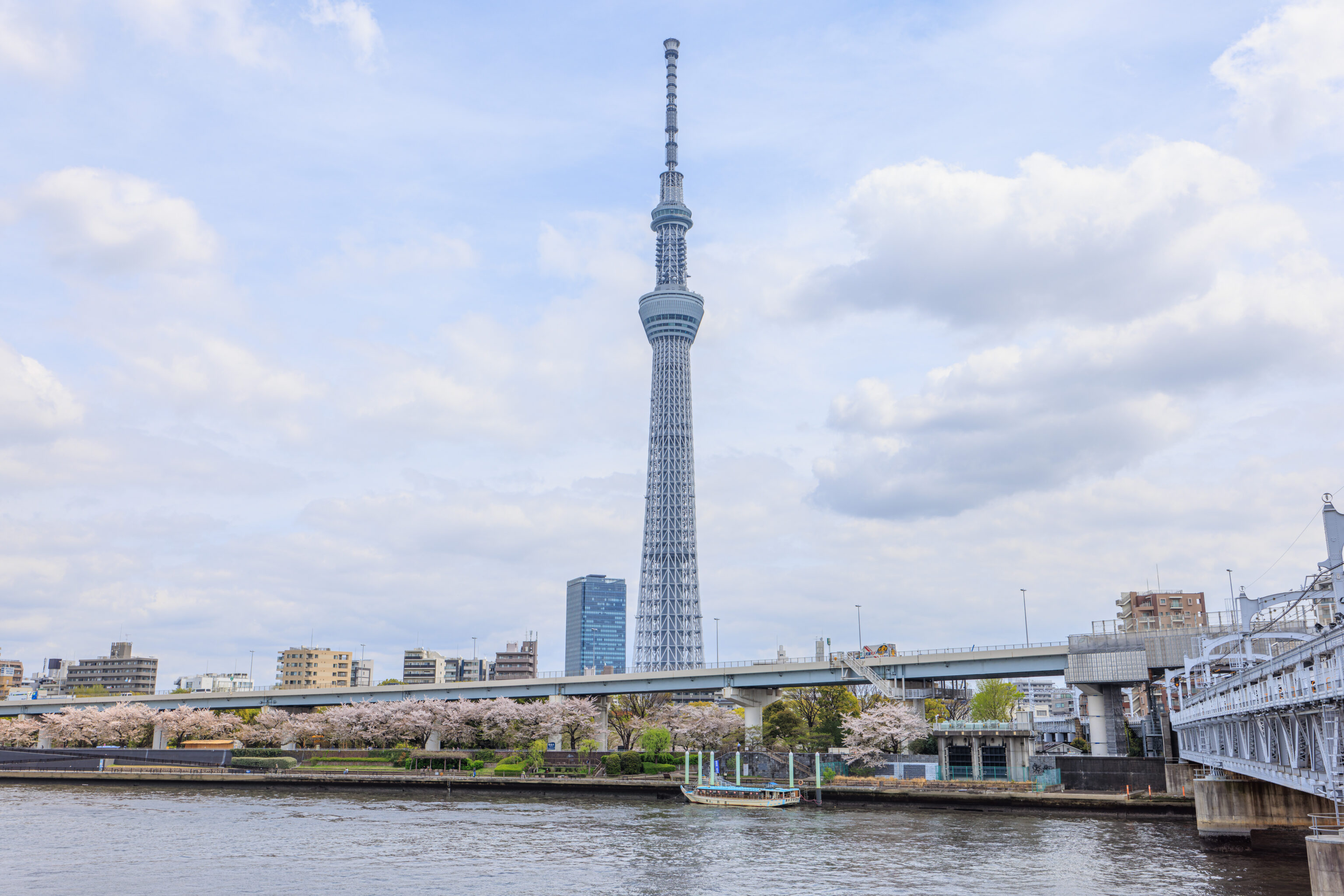
Tokyo Skytree, as seen from the ramp that goes to ground level from the bridge’s upstream side.

The upstream view from the ramp. By now, it was 12:30pm and we were hungry!
Lunch
We walked back to Asakusa Station and caught a subway to Ueno Station.

The main hall of the JR station has some nice art up high. We took the Yamanote Line down to Tokyo Station.

After arriving at Tokyo Station, we walked over to KITTE Marunouchi. Kitte means stamp. This building, containing an office tower and shopping mall, incorporates parts of the former Tokyo Central Post Office. We noticed this large Yuzen dyed artwork on the wall. It is for a soba restaurant, Shinshu-Matsumoto Hikariya. Shinshu was a former province which included the town of Matsumoto, which is now in Nagano Prefecture. The image depicts a scene with Matsumoto’s famous castle in the background as well as the snow capped peaks of, presumably, the mountains to the west.
We visited Matsumoto Castle in 2019, and crossed over the mountains along the Tateyama Kurobe Alpine Route on April 18th and 19th last year.

We are here in KITTE to visit Nemuro Hanamaru for kaiten sushi. We have consistently tried, and failed, to eat here ever since they reopened after a renovation! We always arrived too late in the evening to get a spot on the queue, or arrived with insufficient time to queue. We arrived at around 1:15pm and ended up having to wait around 25 minutes before being seated. Not too bad!.
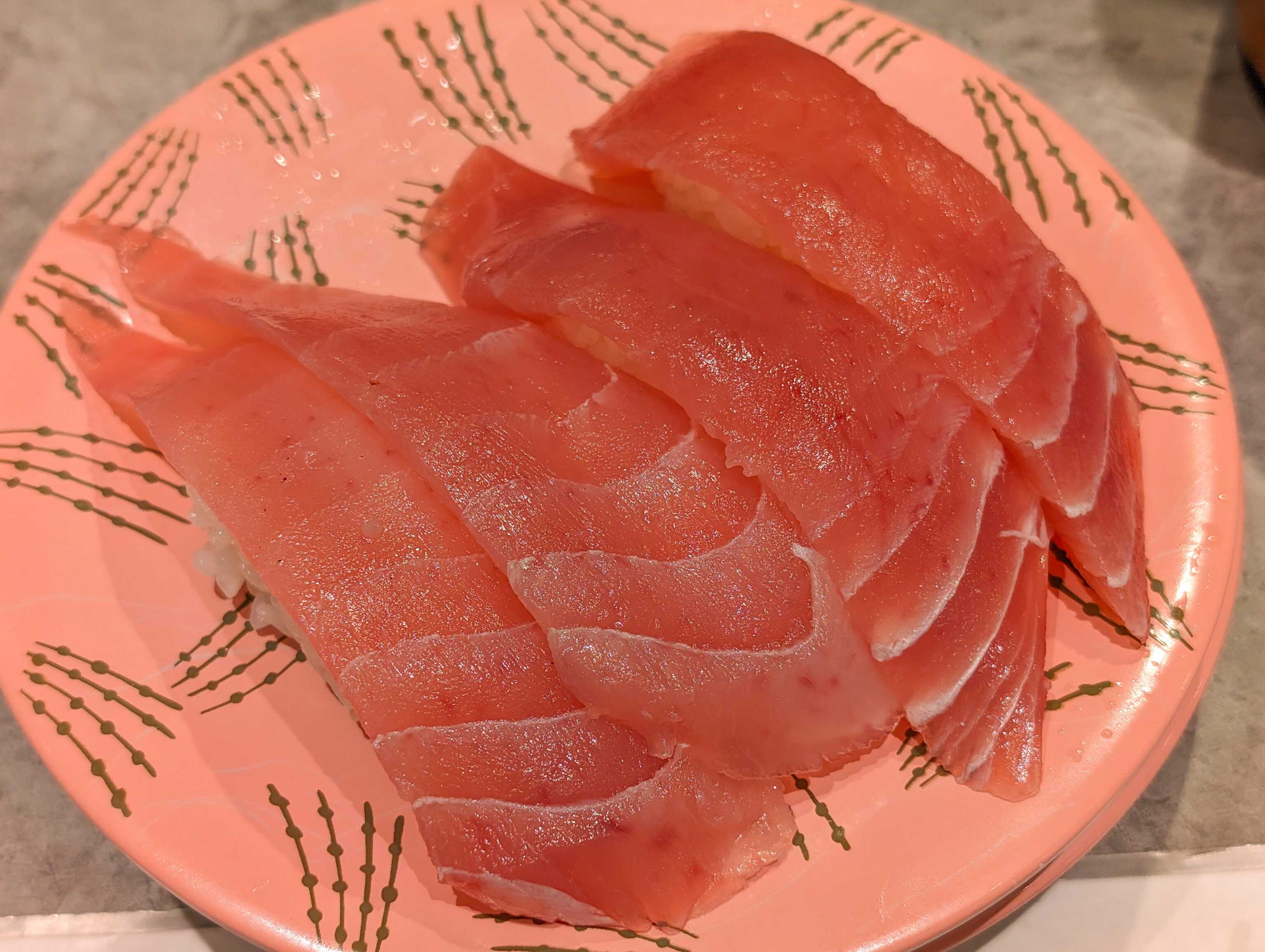



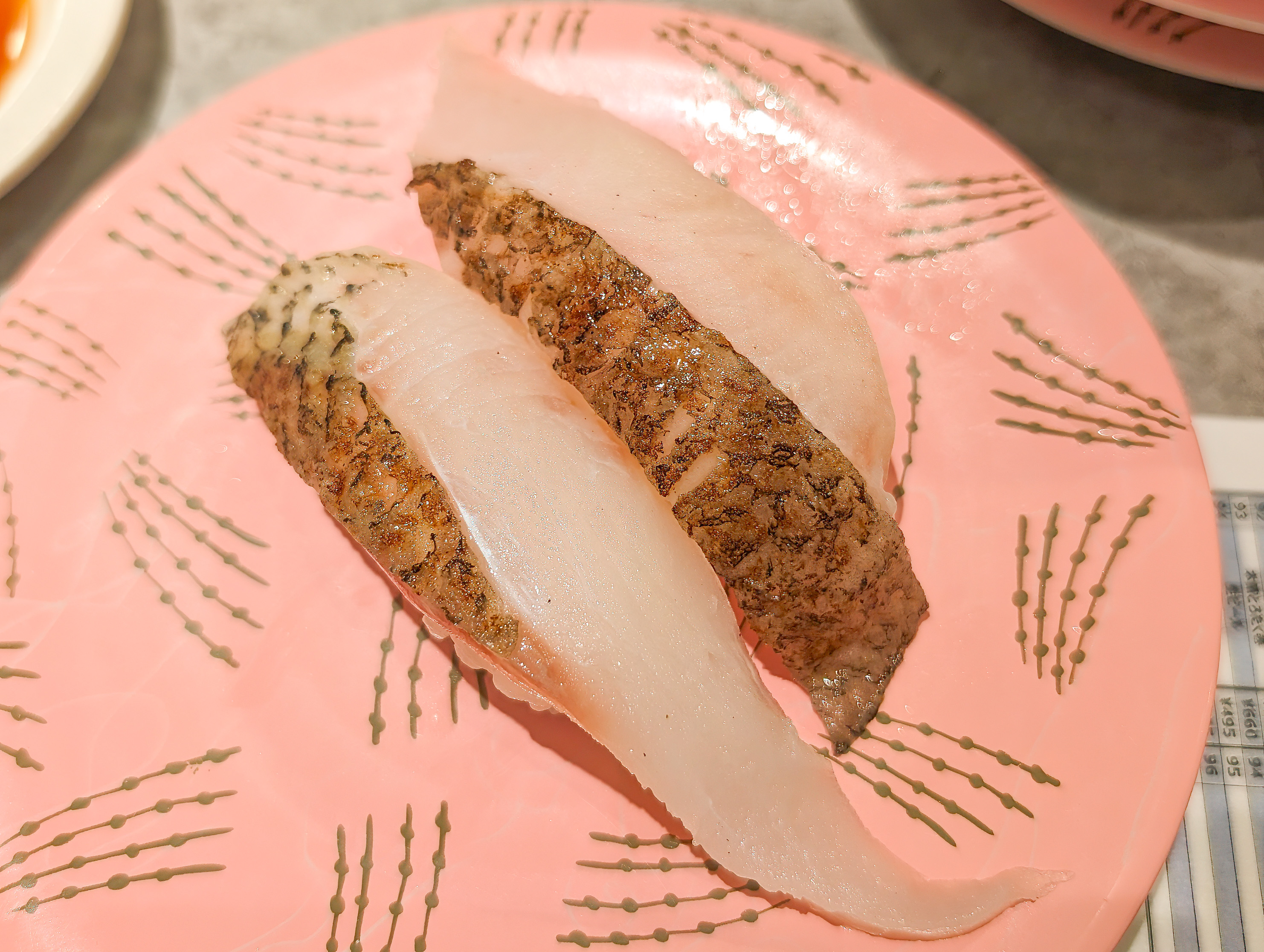





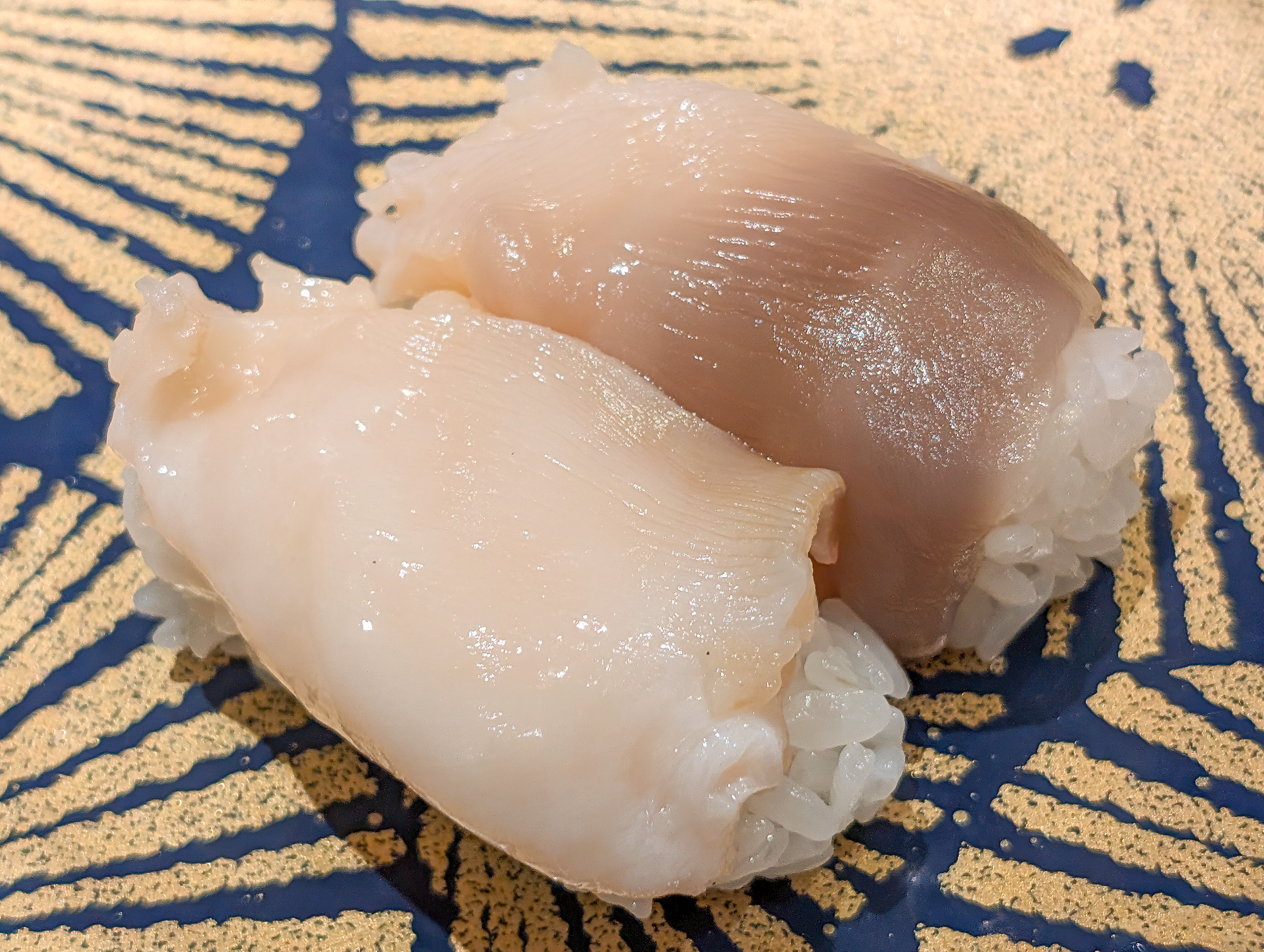

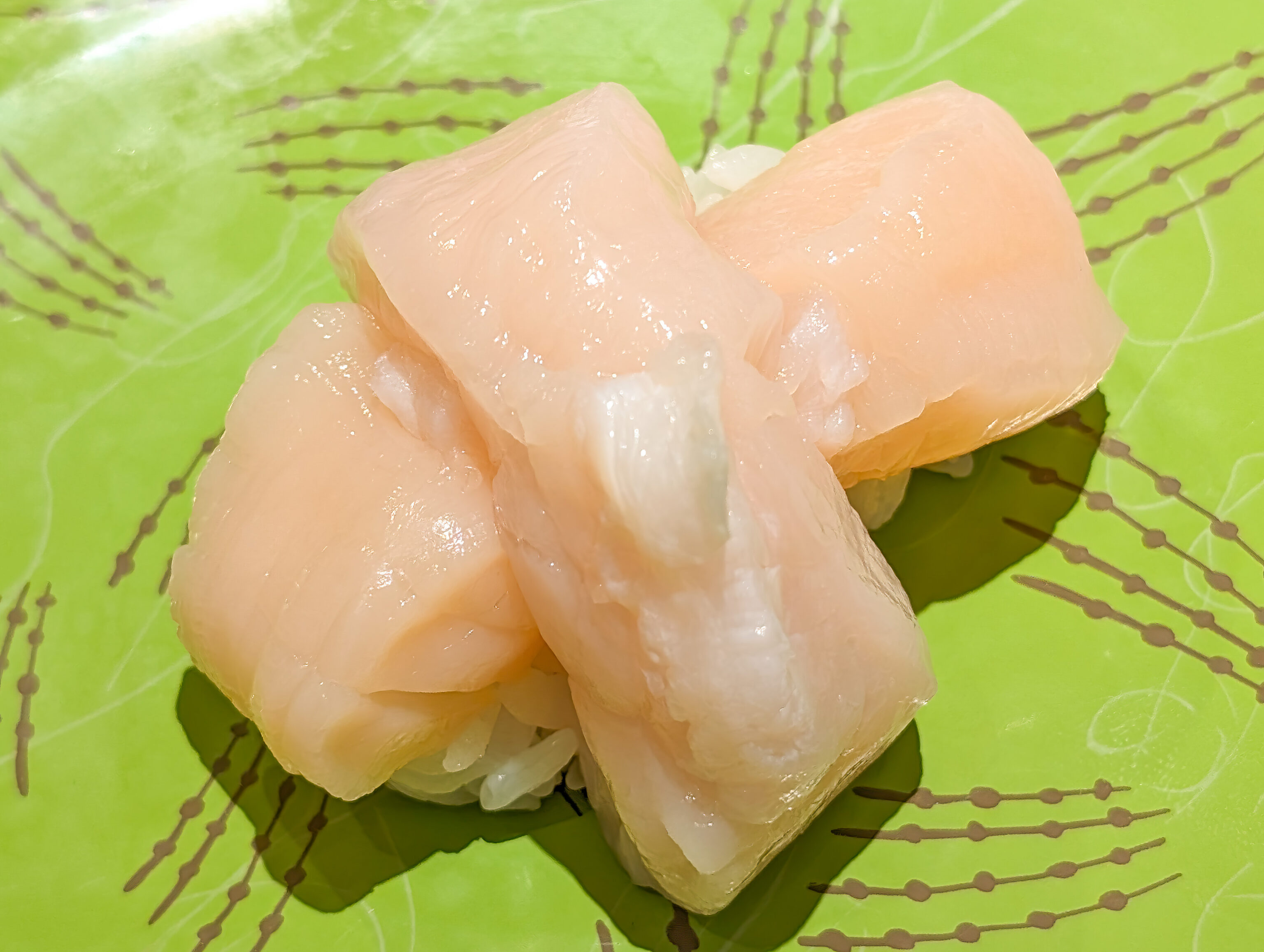
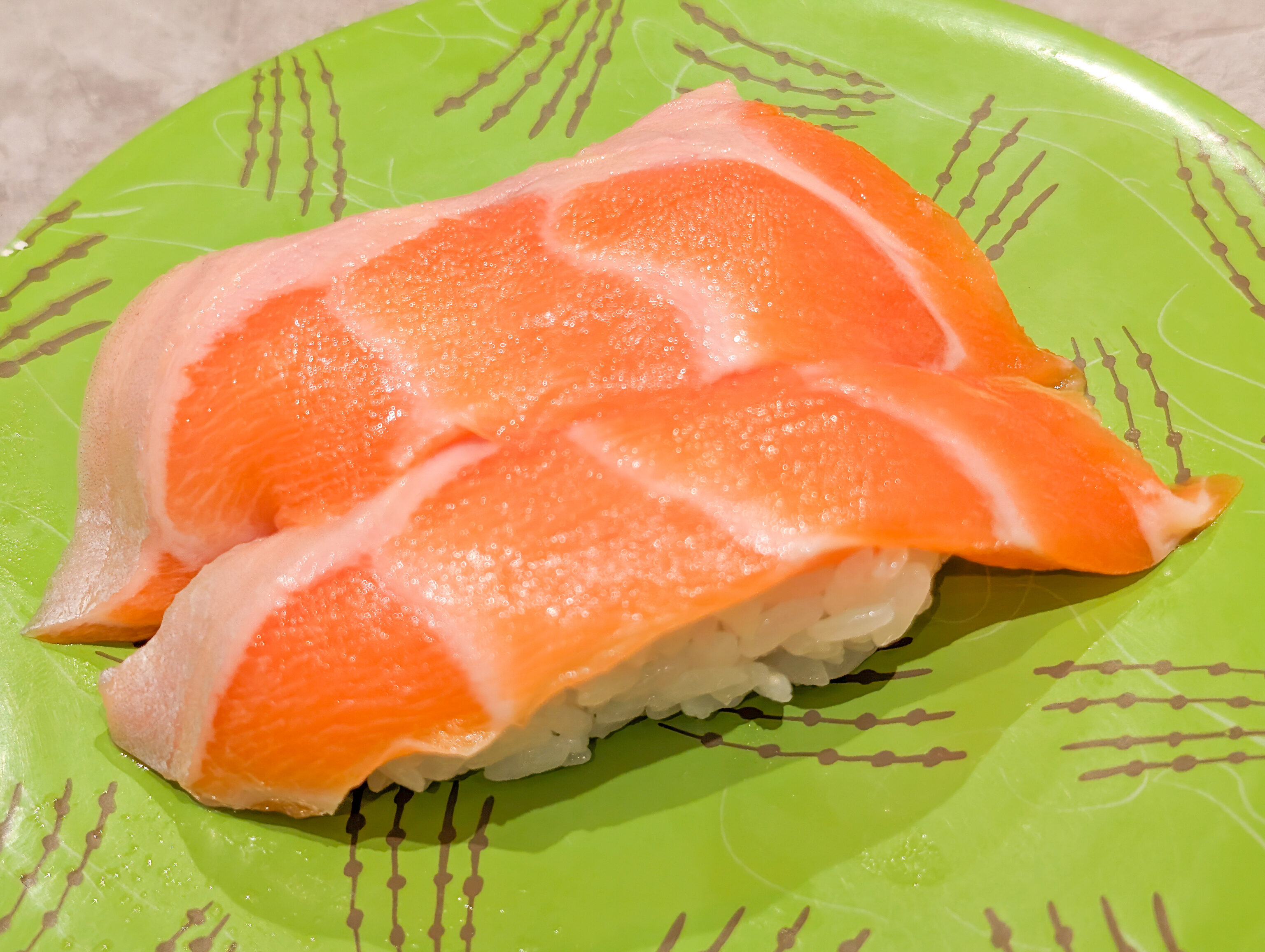


We ate quite a bit today! These are all the seafood items that we consumed. The salmon was particularly good today. For whatever reason, in the past, we felt the salmon in Japanese sushi restaurants was merely OK, particularly compared to the tuna. The seared salmon was also incredibly good.




We also had Hokkaido crab gunkan, crab miso soup, uni, and karaage. The weakest item here was the karaage, though perhaps not entirely surprising given that this is a sushi restaurant. The crab miso soup didn’t really work too well either, and the crab was difficult to pull out of the shell without proper tools.
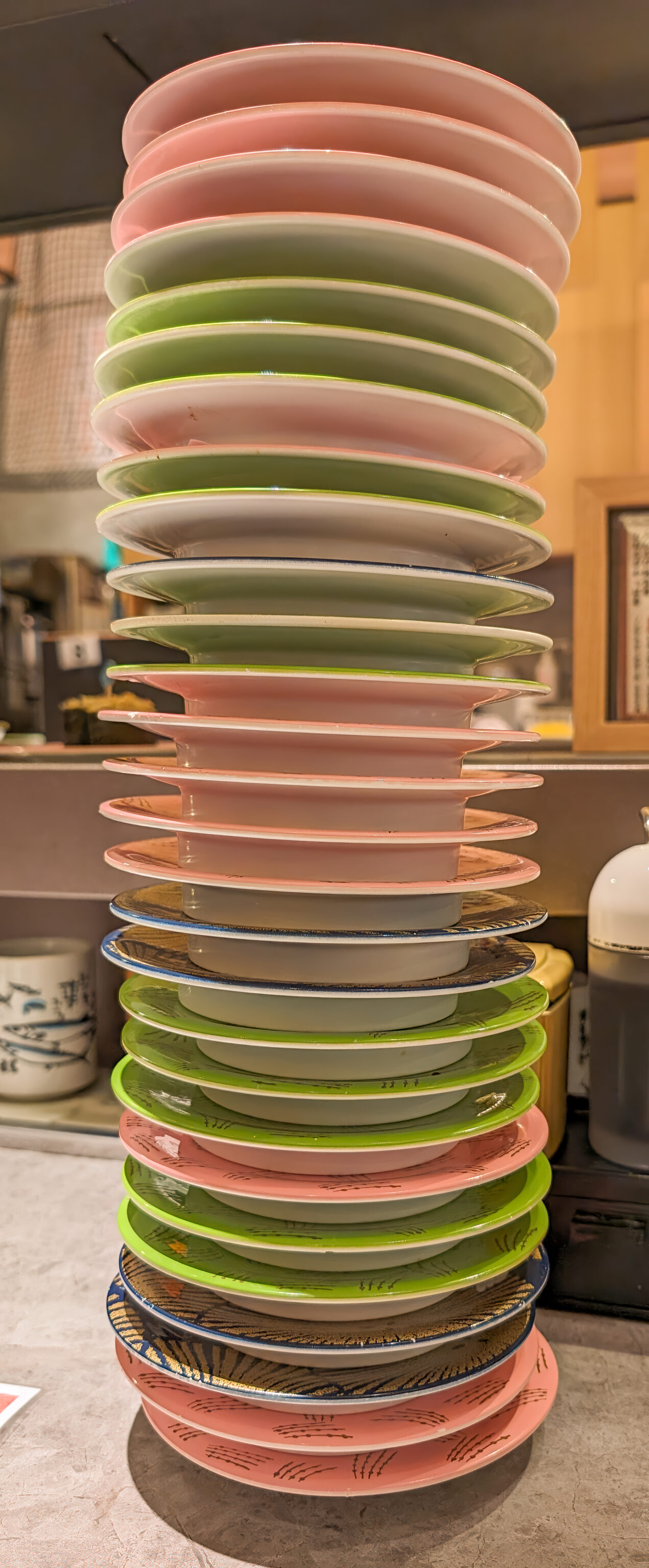
We definitely ate more than anyone else we saw in the restaurant! We had 28 plates! Sushi in Japan is typically fantastic so we try to eat as much as we can when we have it. Sushi of similar quality and variety would be extremely expensive in the US.
Chidorigafuchi
After lunch, we took the Hanzomon Line to the Hanzomon Station. From there, we walked a few blocks east to reach the Chidorigafuchi Moat, on the northwest side of the Imperial Palace. We then started to walk clockwise around the outer side of the moat. This is the same area we were at yesterday when we thought there would be illuminated sakura and is referred to as the Chidorigafuchi Green Way. There is also the Chidorigafuchi Park, which seems primarily just to the south of where we arrived but may also include the Green Way.

We didn’t really see many sakura when we arrived at the moat. The sakura tree to the right looks well past peak with many leaves, though it still has many petals that haven’t fallen.

There were more trees as we continued walking by the moat. Though looked to be well past peak though and not as pretty as the ones we saw at Sumida Park.


We continued walking through the park. It is a rather narrow strip of parkland that runs along a pedestrian path and small adjacent road.
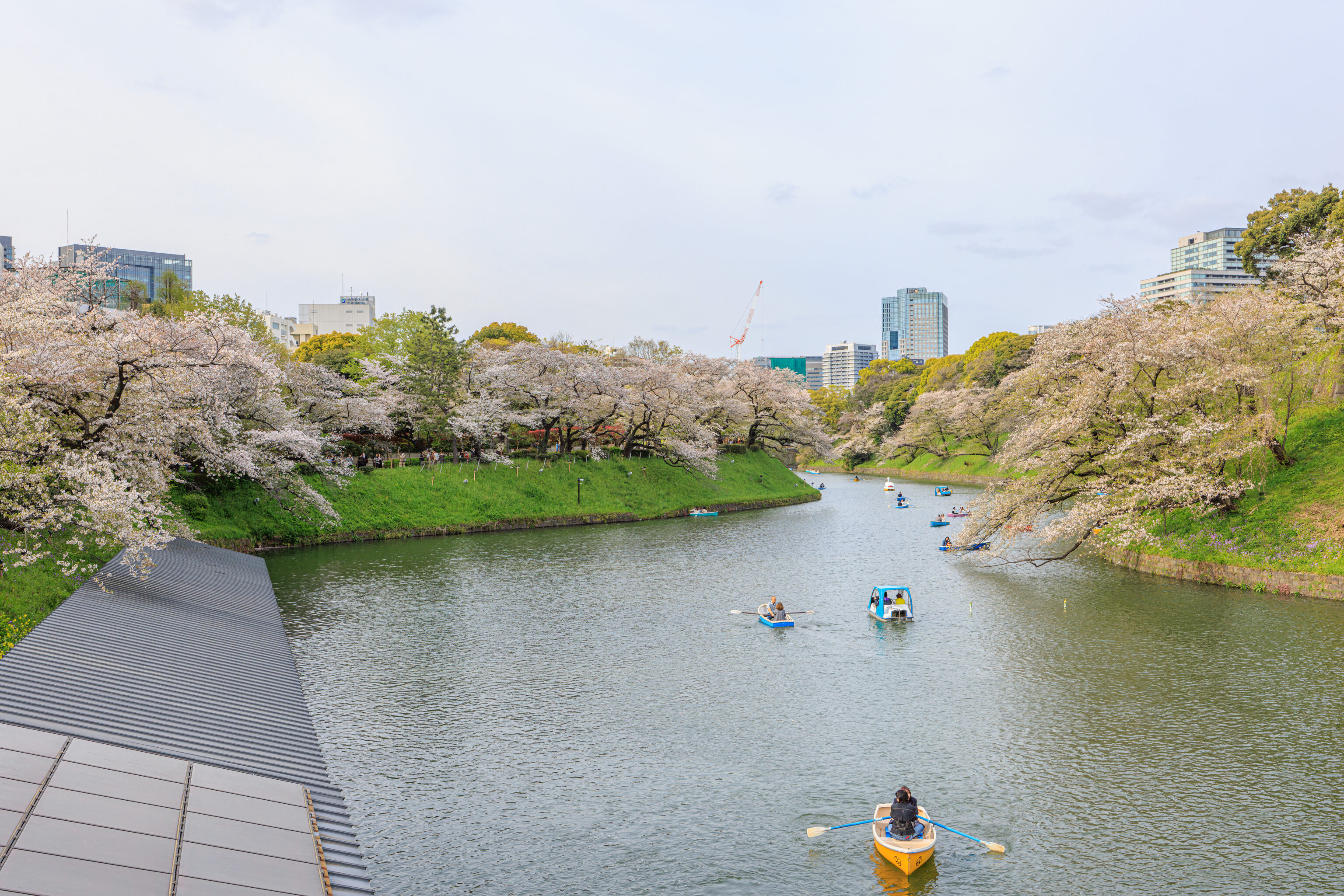
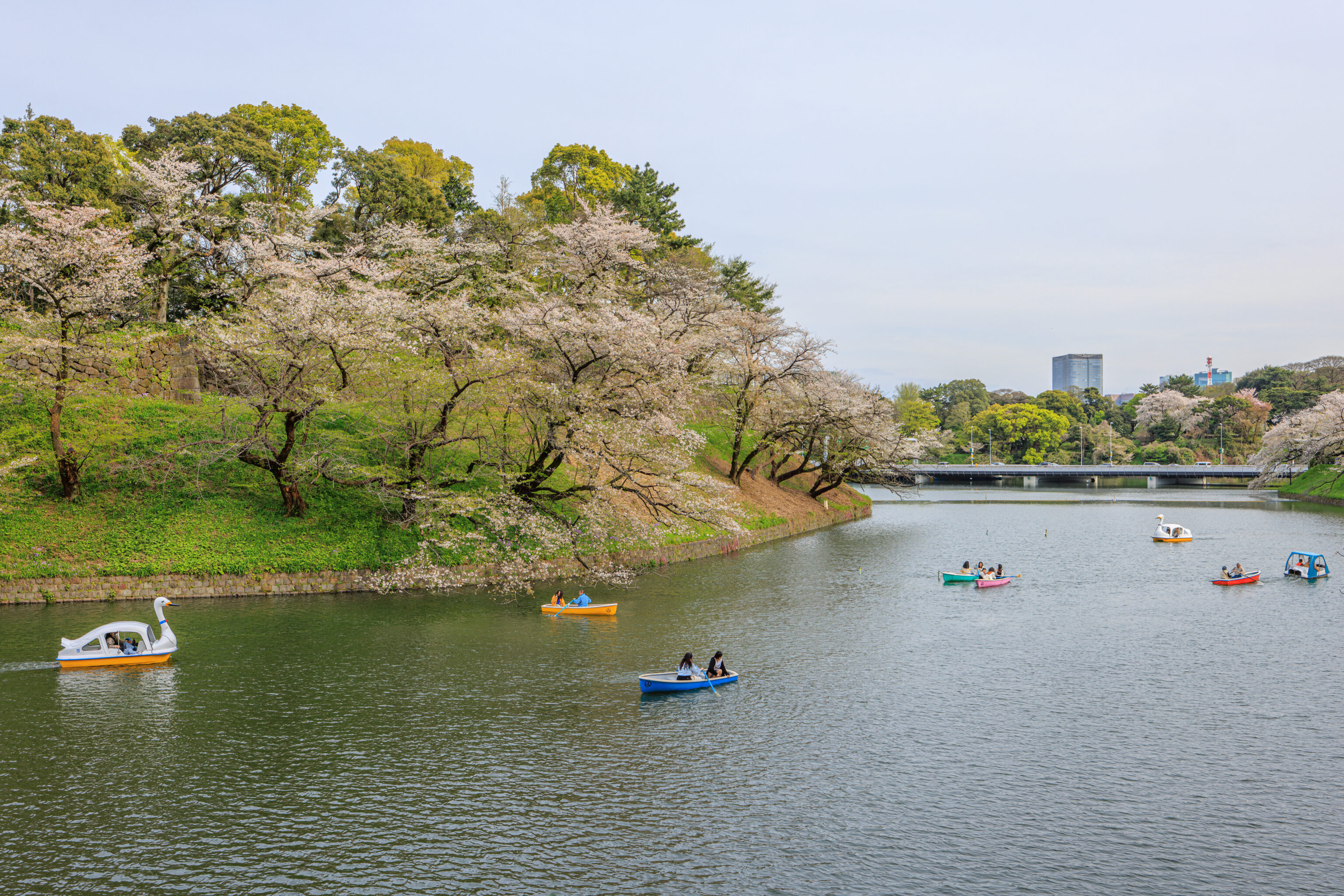

Many people were enjoying boats of various types in the moat. The queue to rent one looked extremely long! We saw a few gentle collisions here and there.


Two close ups of some of the better looking sakura.


We continued on until we saw where we were last night. We had walked to the row of trees in the background, though it was too dark at the time to really see much of anything.

After reaching the northwest corner of the moat, we continued following the moat to the east, heading to Kudanshita Station.

We were here yesterday! The top of the Tokyo Tower is a bit more obvious at night when it is brightly illuminated.
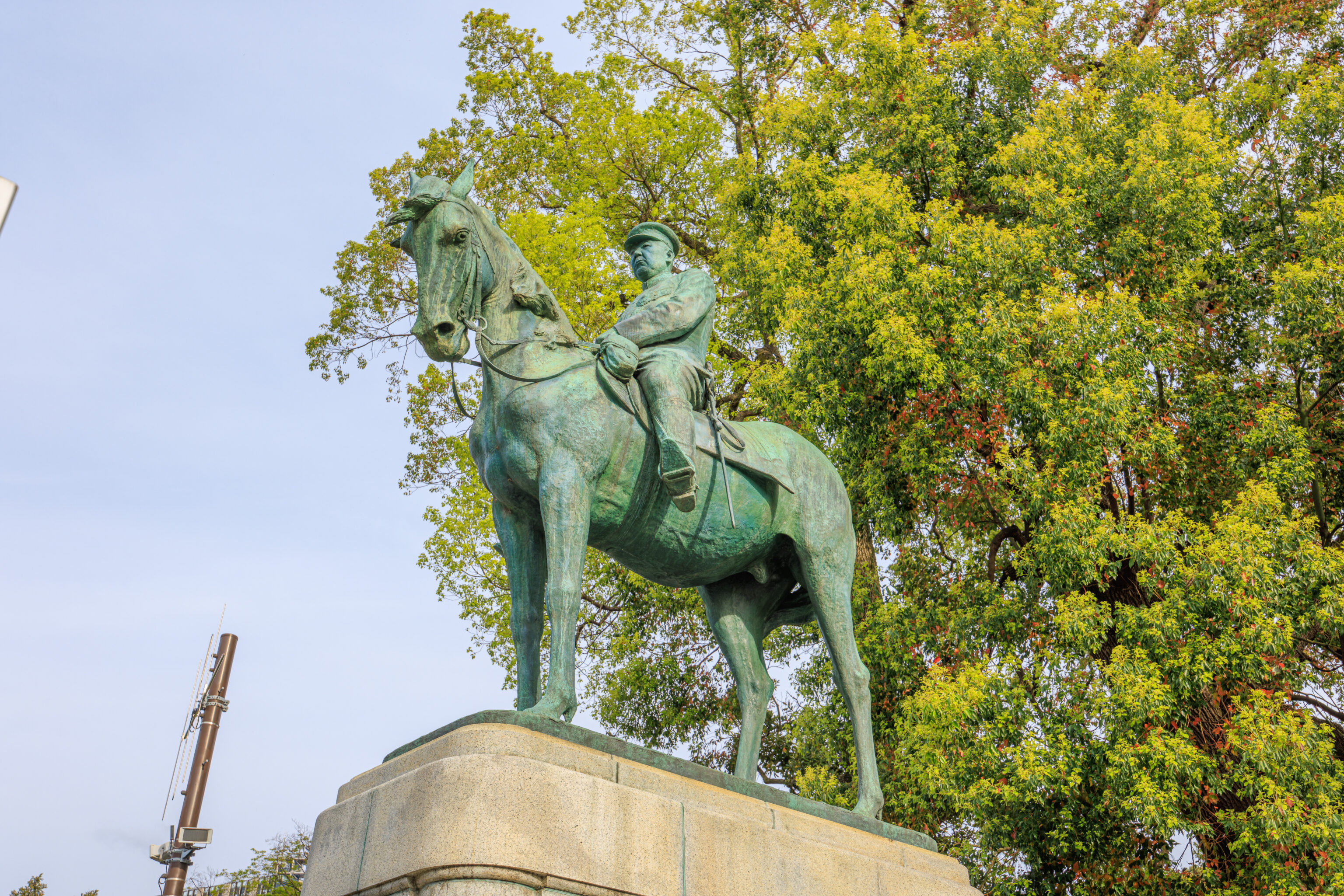
We saw this equestrian statue of Iwao Oyama yesterday evening. A sign provides a brief description of the person and statue:
Iwao Oyama (1842-1916)
In 1842, Iwao Oyama was born in Kagoshima to a samurai family of the Satsuma Domain. His cousin, Tsugumichi Saigo, brother of Takamori Saigo, was his sworn friend. He was influenced by the modern armament in the War of Great Britain, and acquired artillery under Tarozaemon Egawa.
During the Sino-Japanese War, he was appointed the commander-in-chief of the Japanese Second Army, and during the Russo-Japanese War, he was a field-marshal and served as the commander-in-chief of the Japanese armies in Manchuria. Often paired with Admiral Heihachiro Togo to be referred to as "Oyama of the Land, Togo of the Sea." In later life he served as the Chief of the Army General Staff, Home Minister, and was given the title of Genro (elder statesman).
The Statue of Iwao Oyama
On November 3,1919, the statue of Iwao Oyama was installed in the park in front of the National Diet Building. The bronze statue of a horse-riding figure in military uniform was created by a sculptor, Taketaro Shinkai. This is one of a few horseback riding statues among the modern military statues.
In 1948, it was temporarily removed by GHQ, deposited at the Tokyo Metropolitan Art Museum, and then moved to its current location in 1969.
An Explanation of Monument in Honor
Field marshal with the highest rank of the Empire of Japan, Iwao Oyama was born on November 12, 1842, in Kagoshima. After serving in both the Sino-Japanese and the Russo-Japanese wars, he returned to Tokyo where he died on December 10, 1916.
千代田区 Chiyoda City
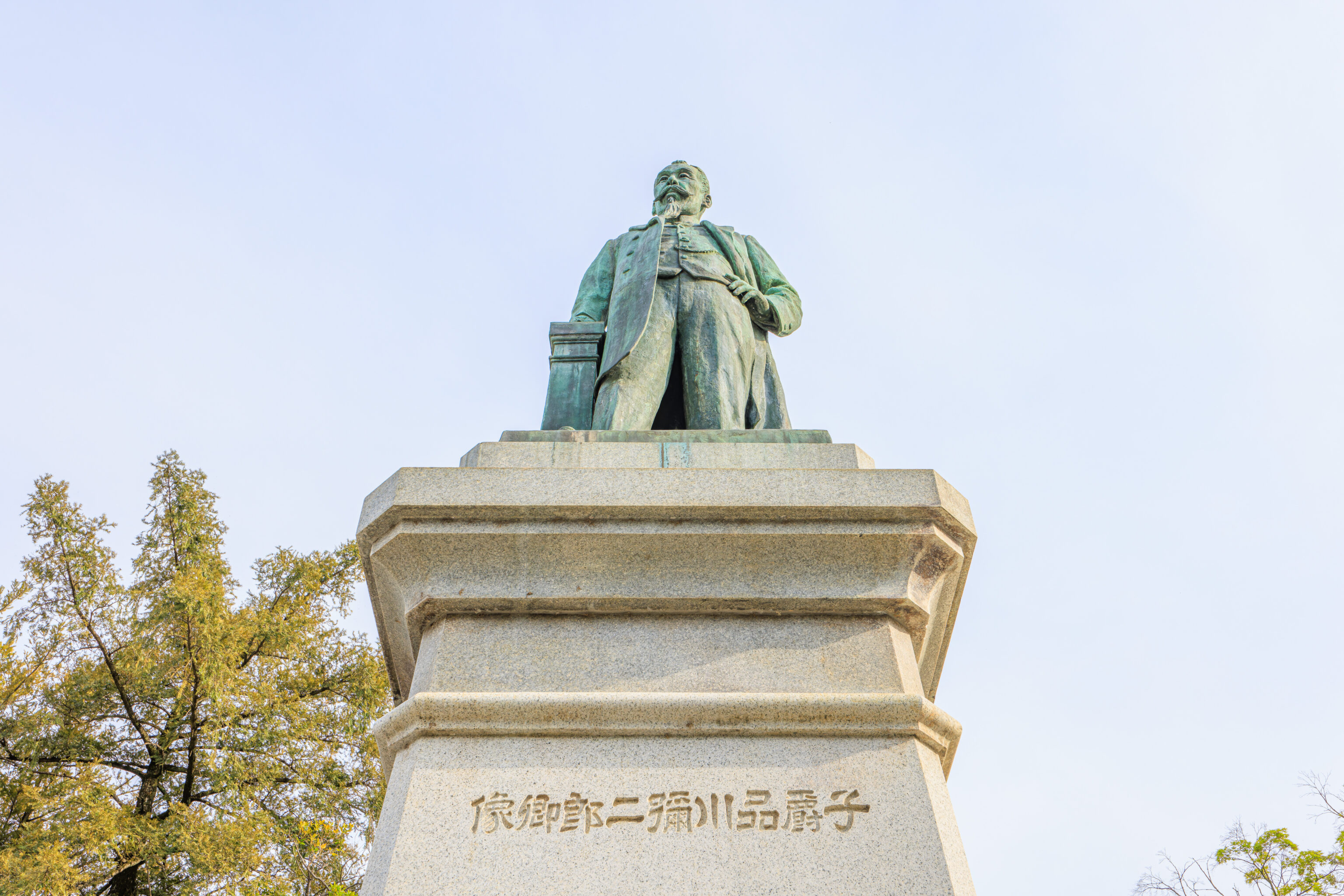
There was also a statue of Yajiro Shinagawa. Once again, a sign provides some information about the man and statue:
Yajiro Shinagawa (1843-1900)
In 1843, Yajiro Shinagawa was born in Hagi, former Choshu Domein.
Yajiro attended Shoin Yoshida's Shoka Sonjuku Academy, and he improved his skills of his swordsmanship at the Renpeikan Training Hall. Subsequently as a samurai of the Choshu Domain, he joined the Sonno-joi movement and Boshin war with Renpeikan classmates such as Shinsaku Takasugi.
After the Meiji Restoration, he was dispatched to Europe in 1870, gradually becoming interested in politics and economics.
After returning to Japan, he worked for three ministries such as Ministry of Home Affairs, Agriculture and Commerce, and the Imperial Household. In 1891, he was appointed the Home Minister in the cabinet of Prime Minister. He was involved in the formation of schools, credit unions and industrial cooperatives.
The Statue of Yajiro Shinagawa
The statue of Yajiro Shinagawa was erected in 1907. He learned his swordsmanship at Renpeikan (which was the current Kudan-kita), and it was built near Rempeikan in Kudanzaka Park. The director was Koun Takamura, the original sculptor was Hakuun Motoyama, the caster was Komajiro Hiratsuka.
Koun Takamura: a Japanese sculptor who had learned wood carving under the Buddhist sculptor Toun Takamura since 1863. He is also known for having incorporated Realism into wood sculpting, as well as nurturing Choun Yamazaki, Denchu Hirakushi and other upcoming artists. His works such as the statues of Roen, Masashige Kusunoki and Takamori Saigo, are well known.
千代田区 Chiyoda City

There doesn’t seem to be much information about this light when searching its name, 高燈籠 (常燈明台) Takatoro (Jōmeidai) in English. The Chiyoda-ku website provides some history, translated to English via Google Translate1:
It was built in 1871 as a night light in front of Yasukuni Shrine. It is said to have been built for the spirits enshrined at Yasukuni Shrine (then Tokyo Shokonsha). Officially it is called Takatoro, but it is also called Jotomeidai. At that time, from the top of Kudanzaka, you could see Mt. Tsukuba and the mountains of Boshu in the distance, and it also served as a lighthouse and served as a very good landmark for ships traveling off the coast of Shinagawa. It was originally built on the opposite side of Yasukuni Dori, but was moved to its current location in 1930 due to road renovations.
The Yasukuni Shrine is considered extremely controversial in modern times.
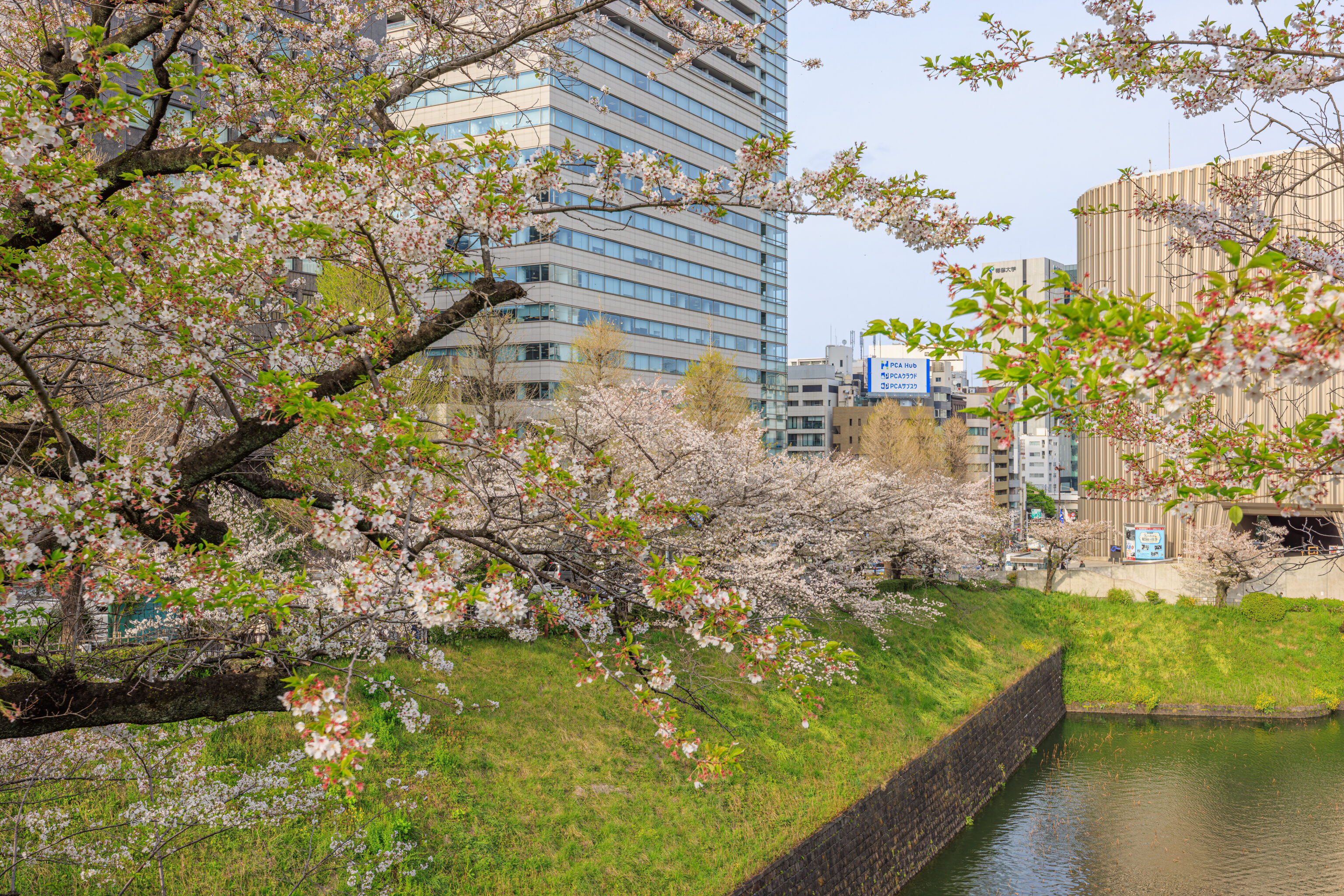
We continued walking to the east to Kudanshita Station. It is just past the building on the right in the background.

There were some pretty cherry blossoms on the moatside slope on the Imperial Palace side.
Back to the Mesm
After arriving at Kudanshita Station, we returned to Hamamatsucho to begin the walk back to the Mesm.


We took the same elevated walkway that we used in the morning.

The Mesm is right at the southern end of the Sumida River where it empties out into Tokyo Bay. Unfortunately, there wasn’t much of a sunset today. The sky mostly just got darker.

We enjoyed the view as the sky continued to get darker.

There is a bit more of a close urban view to the northwest beyond the Hamarikyu Gardens. We were pretty full after our huge lunch so didn’t go out for dinner tonight. We were pretty tired anyway, having not slept for enough time last night!


